What to Do in Lisbon: A Complete Guide (for First Timers)
In a lot of ways, Lisbon reminds us of San Francisco, which is where we met and spent our first eight years together. It has plenty of hills (which means both incredible views and also getting sweaty trying to get to those views), it has a big red bridge, and it’s earthquake prone.
Same-same, but different, right?
One of the first things you’ll learn about Lisbon is that the city was essentially leveled in the middle of the 18th Century, when a huge earthquake (and the subsequent fires) destroyed huge swaths of the city.
That devastating disaster came when Portugal was at the peak of its powers in terms of global influence (many of the world’s preeminent explorers in the Age of Discovery came from Portugal, like Vasco de Gama).
But that fateful day in 1755 changed everything.
What emerged from the ashes of the earthquake is a more modern city (and country, really), which is most evident when you walk through the grid layout of the Baixa neighborhood, which was largely created in the post-earthquake period by Marquis de Pombal.
We could talk for hours fifteen minutes or so about how the earthquake changed Lisbon forever, but the point we’re trying to make here is that Lisbon has been in a constant state of evolution since that devastating moment, and particularly over the past few decades.
In the past five years or so, I swear that every single person I know has visited Lisbon, including my mom, Alysha’s best friend, and the contractor who did the tile in our bathroom.
As you might imagine, that rapid growth in tourism has led to some new challenges, like a rising cost of living that is pricing out many locals (among other things).
Lisbon is now officially on the tourist map, and there is a nearly unlimited number of things to do and see in Portugal’s capital.
In this guide to what to do in Lisbon, we’re not going to give you a list of every single museum, park, square, and church that you could possibly see in Lisbon.
Instead, we’ll offer you a blend of the main attractions in Lisbon – what they are, some brief historical context, and how to see them – but we’ll also give you some of our other favorite things to do that a lot of visitors just completely miss.
Armed with that (and our guide to planning a great Lisbon itinerary), you’ll be ready to plan a trip that will go a level deeper than most and learn about the different aspects of Lisbon’s history and culture that have shaped the city as we know it today over the many centuries it has been in existence.
Learning is our favorite part of travel, which you’ll probably realize as you read this guide.
Sound good to you? Let’s get into it.

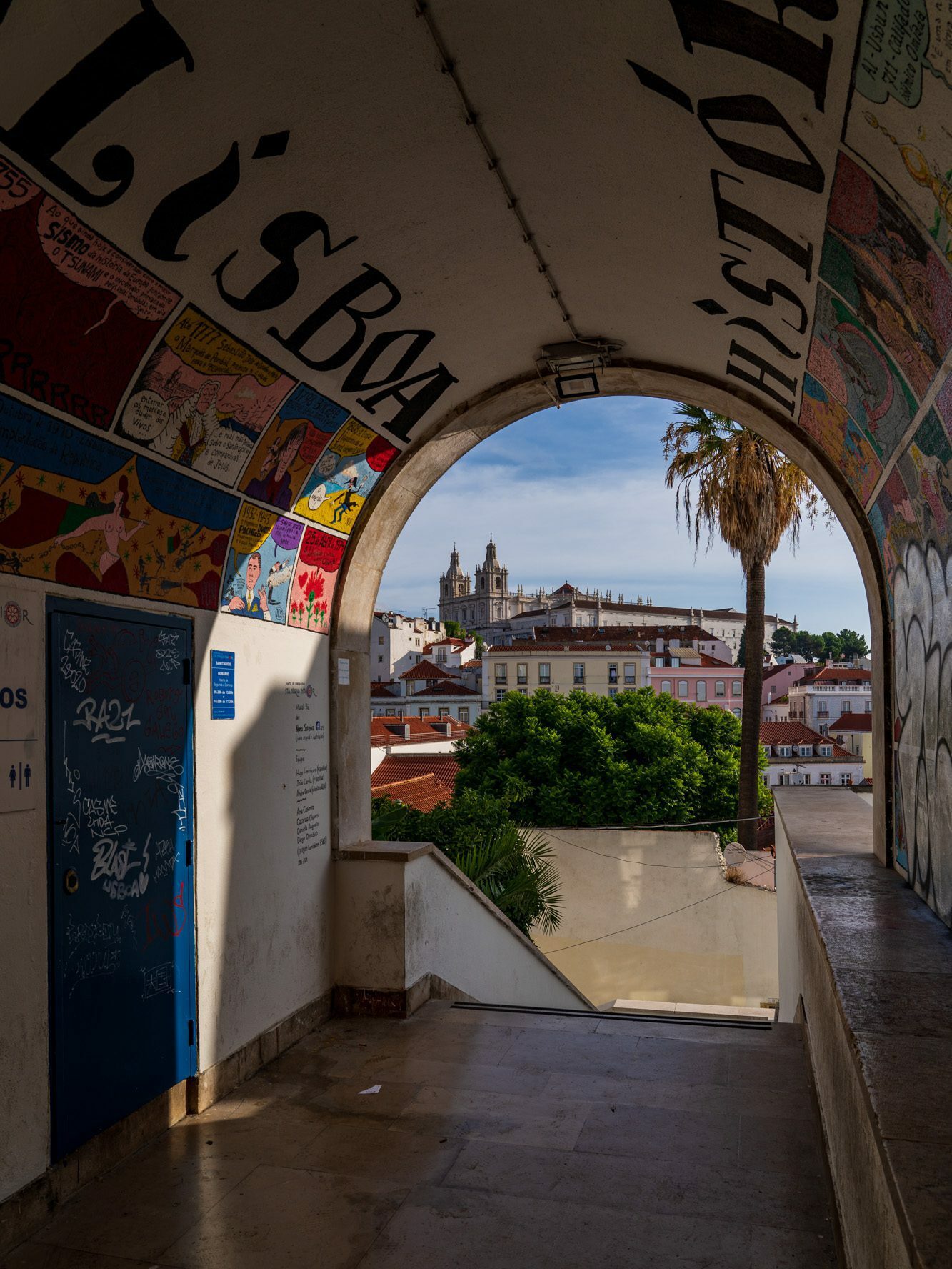
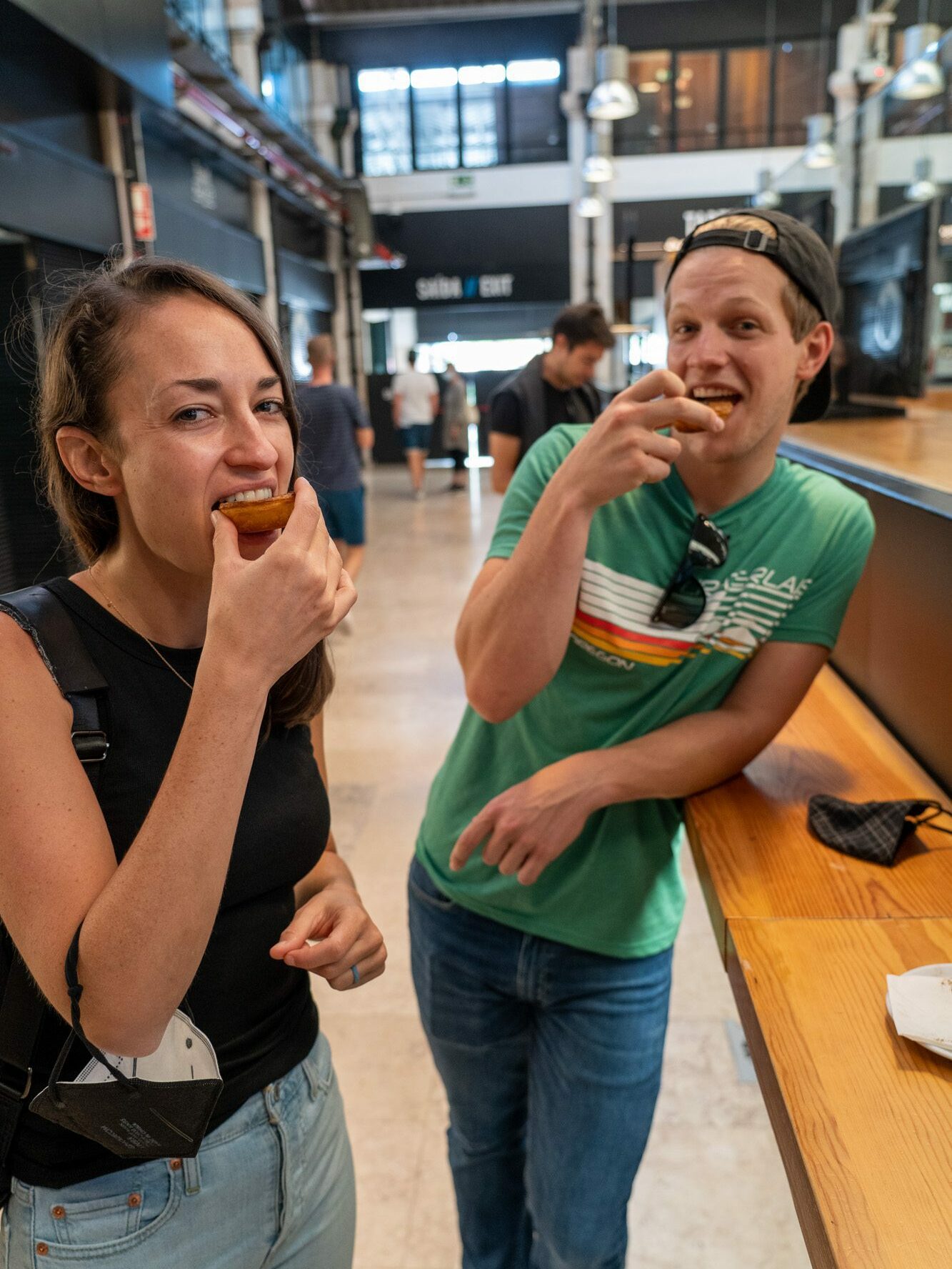
Disclaimer: Some of the links in this post, like hotel links, are affiliate links, meaning at no additional cost to you, we make a little bit of money if you click through and book. That being said, we would never recommend something to you that we don’t stand behind 100%.
Get Oriented with a Walking Tour
One of our favorite things to do in any city, including Lisbon, if you want to learn more about the city and its fascinating history is a guided walking tour. A tour is also a great idea if you want to see as much as possible with limited time in the capital.
Like, for instance, where to find the best pastel de nata in Lisbon (more on that in a second).
We almost always start our trip to a new city with a walking tour, and think you should too.
We’ve actually done several walking tours in Lisbon at this point, and have three recommendations depending on what you’re looking for.
They are our favorite way to get oriented in a new city for a few reasons.
First, you get a crash course in history and culture, which is a valuable baseline that will make the rest of your trip more enjoyable.
Second, you get to spend a few hours with a local who will give you all sorts of tips about what to eat, drink (and see), and specifically where to find the best version of said things.
Last but not least, you’ll discover places that you definitely would never have found on your own.
On our first day in Lisbon a few years ago, we had a group of four (us and Matt’s two brothers) and we scheduled a walking tour with Withlocals for our first afternoon so that we had something to do (other than fall asleep due to jet lag).
The tour we did is the “Lisbon Highlights and Hidden Gems” tour, which is a great introduction to the city.
Withlocals is a tour company that we’ve fallen in love with in Europe, and have basically used in every city we’ve visited over the last few years where tours are available.
They’re perfect because they’re private tours (at regular tour prices, I might add, especially if you have more than two people), and thus they’re customizable to your particular needs and interests.
We did a tour with Isabel in Lisbon, and highly highly recommend her as a guide.
If you’re not a group of 3+, the private tours might not work out as well from a money standpoint, and we have a couple of group tour recommendations too.
On my latest trip to Lisbon, I was in search of a walking tour to do on my first day to get reacquainted with the city and ended up as the only participant on Humberto’s LisboaLove walk.
It’s a small group tour that focuses on the history of Lisbon and makes its way through Bairro Alto up on the hill, which is where Humberto grew up (it also means that you’re spending most of your time in a neighborhood that only a fraction of tourists ever make it to).
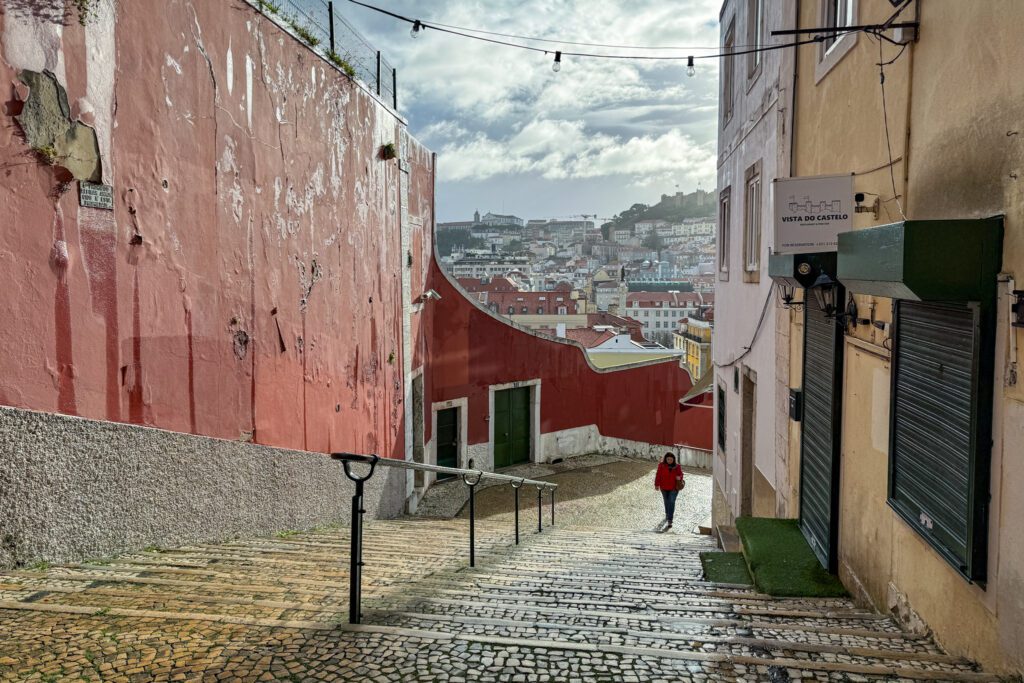
I really enjoyed it, and would recommend it as a nice introduction to Lisbon on your first day if you’re not looking for a private tour.
When we returned to Lisbon at the end of our first trip (which spanned three months across western Europe bookended by Portugal), we spent the better part of a week revisiting Lisbon on our own.
We were looking for a unique perspective on Lisbon, and stumbled across We Hate Tourism Tours, which is certainly a different take on Lisbon. We did their “A Walk in the Real City” tour and loved it.
If you’re looking for less of a history-focused tour and are more into the idea of talking about modern Lisbon and the challenges it’s facing, this is a great tour that will take you to a completely different part of Lisbon to see the city through the eyes of someone who has seen the changes Lisbon has recently gone through – some good, some bad – and will tackle them head on.
Like we said, we’ve done a few, and they represent a nice range of options depending on what you’re looking for.
Decide on Your Favorite Pastel de Nata in Lisbon
I’m almost certain that one of the first things you know about Portugal is that it’s the birthplace of the pastel de nata, a delicious little egg custard tart that has become extremely popular even outside of Portugal over the past few years.
Now, there are LOTS of opinions on who, exactly, makes the best pastel de nata in Lisbon, and our best piece of advice is to try as many of them as you can to decide for yourself, because the answer depends on what you’re looking for – crispy crust, ooey gooey custard, etc.
The legend goes that the pastel de nata was created by monks from a monastery in Belém wayyyy back in the early 19th Century.
And the story is actually fascinating, and completely plausible.
Next to the monastery, there was a sugarcane factory, and after the revolution in Portugal in 1820, all convents and monasteries were shuttered in 1834, which meant that the monks had nowhere to go, and no way to make a living.
Before that, they bought A TON of eggs (the whites were used for starching robes) and found themselves with some leftover egg yolks, so they started making sweet treats as a little bit of a side hustle (and probably, more importantly, to enjoy themselves).
Ever the entrepreneurs, they sold that recipe to the pastry shop – the same one that exists there today – using that handy dandy sugarcane factory and those eggs. Guess what the two main ingredients are in those pastries? Sugar and eggs.
They started pumping out these “Pastéis de Belém” – which would eventually become known more broadly as “Pastéis de Nata” – and two centuries later, the recipe and methods are said to be almost exactly the same as they were back in the 19th Century.
There are a nearly unlimited number of places to get a pastel de nata in Lisbon. As you might already know (or have guessed based on our name), Matt has Celiac Disease and can’t eat gluten, so his selection was very limited.
However, on that first trip to Lisbon, we were traveling with Matt’s two brothers, and between them and Alysha, we tried a fair amount of pastéis.
Lisbon is home to some of the best pastelarias (pastry shops) and tastiest pastéis (plural of pastel de nata) in the entire country.
We got three recommendations from locals when we asked about their favorite place to get pastéis de nata in Lisbon. These were:
- Manteigaria: Popular bakery specializing in pastéis de nata, with two outlets in Chiado and Ribeira.
- Pastéis de Belém: The historic bakery in Belém is close to the Jerónimos Monastery where the sweet pastry is said to have been invented. This bakery serves the “original recipe” of pastéis de nata (allegedly).
- Pastelaria Aloma: Award-winning pastéis de nata bakery that dates back to 1943, now with multiple locations around Lisbon.
We tried all three to see which version we liked best and Manteigaria was the CLEAR winner.
However, we also found that they were all relatively close and that the more important factor than the specific bakery was whether or not the pastel was fresh and warm, which led to a much better, flakier experience with a nice texture contrast that just wasn’t the same when they were cold.
The point is that you should absolutely source recommendations from people you meet in Lisbon, and try them all for yourself to see which proprietor comes out on top for you.

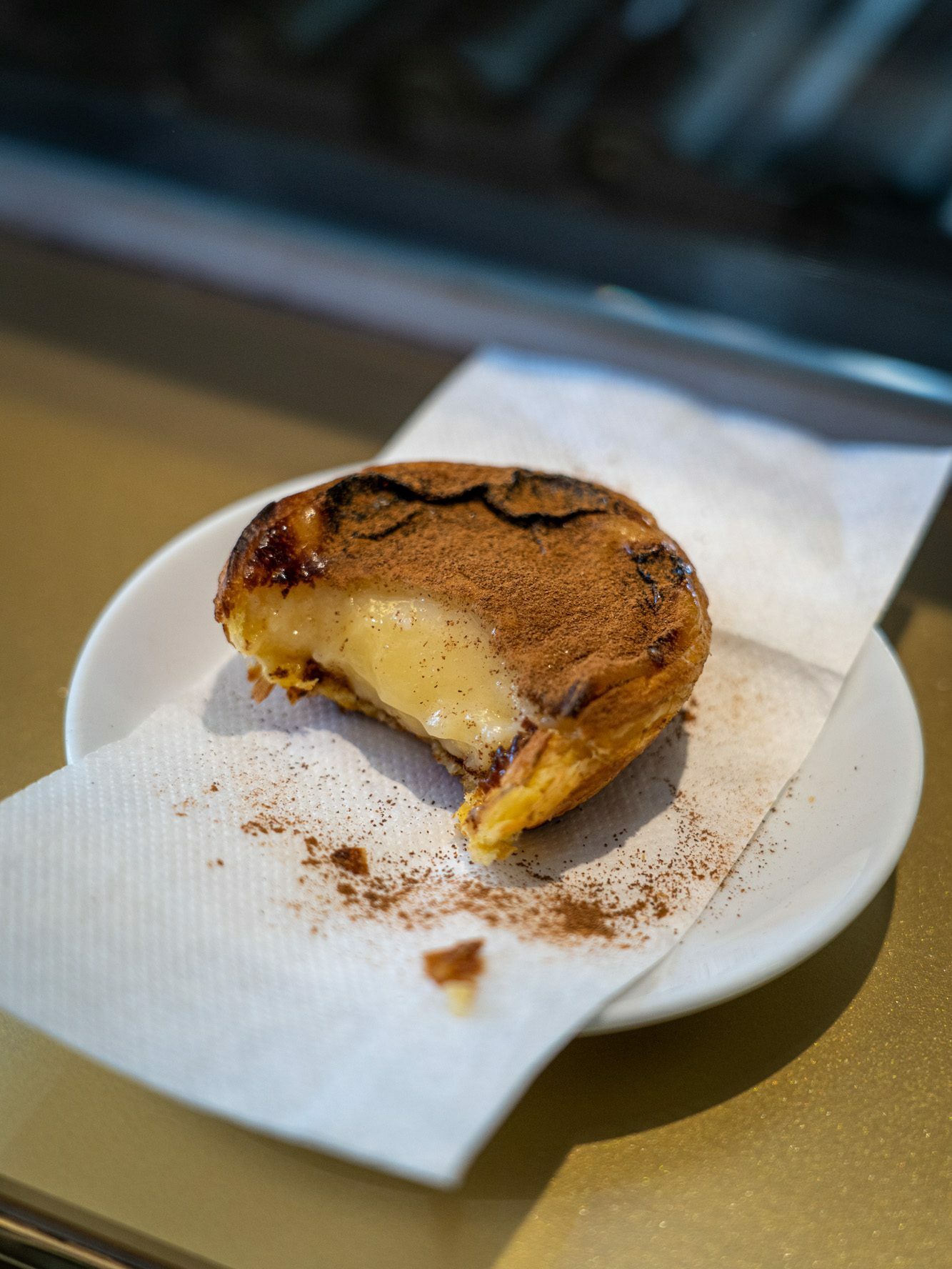
Spend a Half Day in Belém
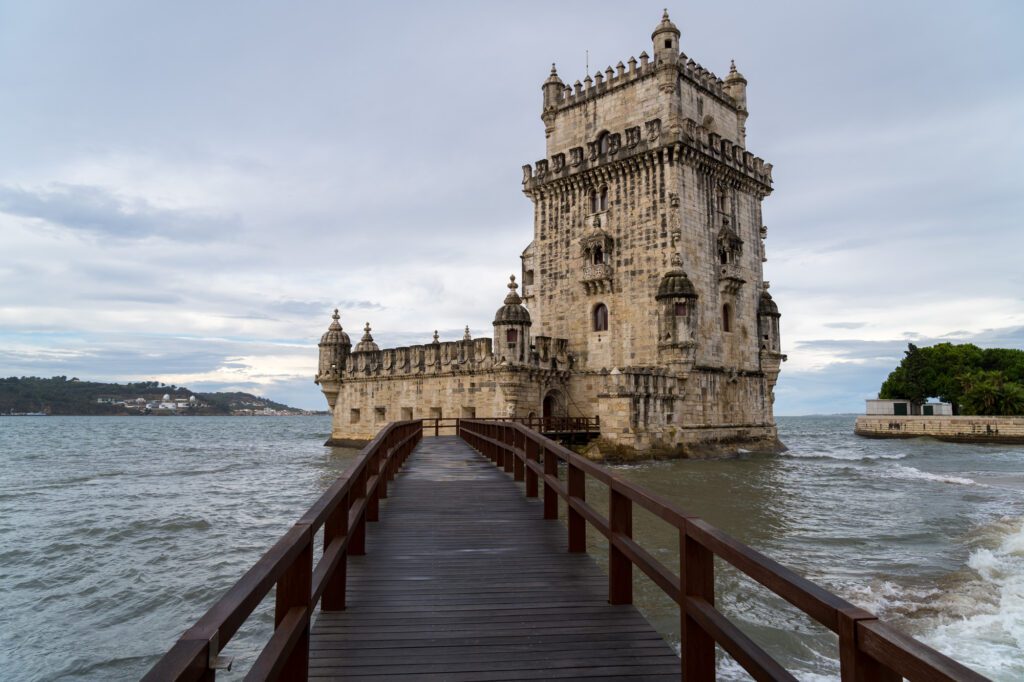
Belém is a slice of Lisbon that is west of the city center along the river Tagus, and at one point it was a separate city.
However, similar to former suburbs in other European cities (like Montmartre in Paris, for example) as Lisbon has expanded it has swallowed it up and now it’s a district within the broader city of Lisbon.
The thing we like about Belém is that it’s a not-so-subtle nod to Portugal’s maritime legacy, which is something that I only really remember as I was standing at the base of the Padrão dos Descobrimentos (Monument of the Discoveries) staring at the recreation of Vasco de Gama’s face.
Since that first trip to Lisbon, I have since been to Venice again, and learned that Vasco de Gama’s trip around the southern tip of Africa led directly to the slow fall of the Venetian Republic by opening up trade with the east – which until that point was controlled almost exclusively by the Venetians.
In an alternate version of history, the earthquake in the 18th Century never happened and Portugal is still a global superpower on the back of its maritime strength (just don’t think too hard about the negative aspects of a huge colonial empire that was knee deep in the slave trade, which Portugal certainly was).
Belém is right along the river, and is home to several cool sights, including the Torre de Belém, a huge monastery, and, perhaps the most important, Pastéis de Belém, which is said to be the birthplace of the original pastel de nata.
Today, the entirety of Belém is a UNESCO World Heritage Site.
We’d recommend starting at the furthest end with the Tower of Belém, then working your way back towards the center of Lisbon.
One shout out to my favorite coffee shop in the city, Tact (here on Google Maps) which is roughly halfway between the city center and Belém and is well worth a stop for coffee lovers.
It’s a lovely little corner cafe where almost everyone inside seemed to know the owners and live in the neighborhood. Very charming.
Getting to Belém: The easiest way to get there from the center of Lisbon is to hop on the 15E Tram from around Praça do Comércio. It takes about half an hour each way, and costs €3 in either direction. You can buy tickets on the tram, but you have to use the machines which sometimes don’t work (they do accept credit cards now though!).
The Torre de Belém
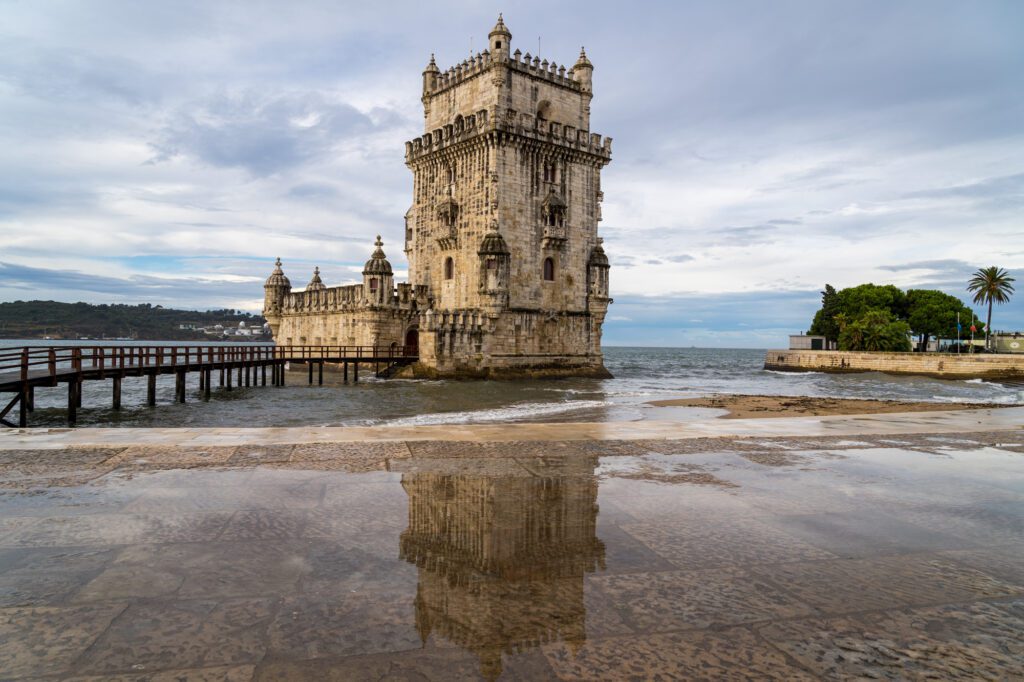
First of all, don’t go up into the tower. We just saved you €15 a person. Lines are long, and the view from the top isn’t really worth the money or the time it’ll take you to get there.
It is, however, worth admiring from the outside because it’s a beautiful building.
It was built in the 1500’s for two reasons – to serve as an entry / exit point for people coming in and out of the city by ship, and to serve as a coastal defense for Lisbon, as it’s ideally placed along the banks of the river near the mouth to fend off any attacks.
Unfortunately, it didn’t do so well on the second front. It was taken in 1580 by the Spanish.
But it was upgraded following that catastrophe, largely living out its days as a prison until it was made a UNESCO World Heritage Site in the 1980’s.
More information on the tower, including tickets, here.
The Padrão dos Descobrimentos
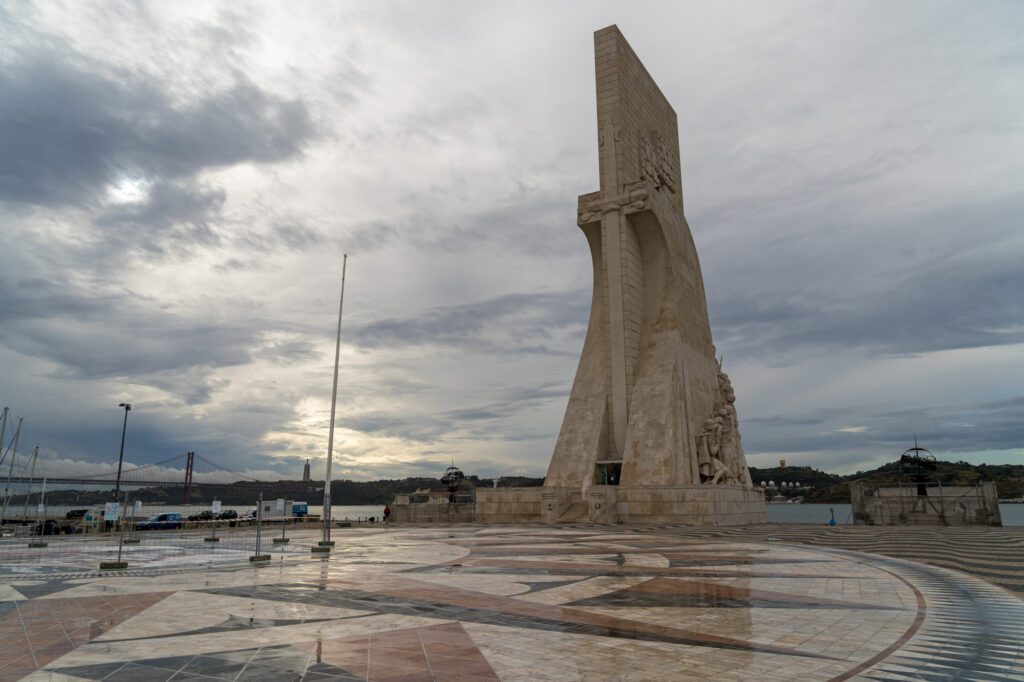
Wander along the waterfront heading east to the Monument of the Discoveries (in Portuguese, Padrão dos Descobrimentos), which is a tribute to Portugal’s amazing history of explorers.
Do you remember from fourth grade who the first person to travel around the horn of Africa over to India was?
I didn’t, but our walking tour guide was quick to remind me that it was Vasco da Gama, and we actually visited the town where he was born just outside of Porto later in our trip to Portugal.
That connection with Asia and the trade it brought to Portugal was a major reason for the rise of Portugal as an influential nation on the world stage during the Portuguese Golden Age (the 15th and 16th Centuries).
Vasco da Gama is one of the figures featured in the depiction on the side of the monument, which was built in the middle of the 20th Century under Portugal’s dictator, António de Oliveira Salazar, who was really into romanticizing Portuguese history.
Naturally, the Age of Discovery in the 15th and 16th Century was near the top of the “aren’t the Portuguese people great?” list, which is problematic because let’s be real for a second – all of the places they “discovered” were… already discovered. Just not by people with a specific shade of skin.
We’re not going to solve that issue here, so I digress.
Anyway, the square in front of the monument is beautiful, with art made from limestone tile donated by South Africa, and the towering monument that rises 171 feet over the river.
You can go inside, but we’d skip it, and instead just admire it from the outside.
The Igreja de Santa Maria de Belém & Jerónimos Monastery
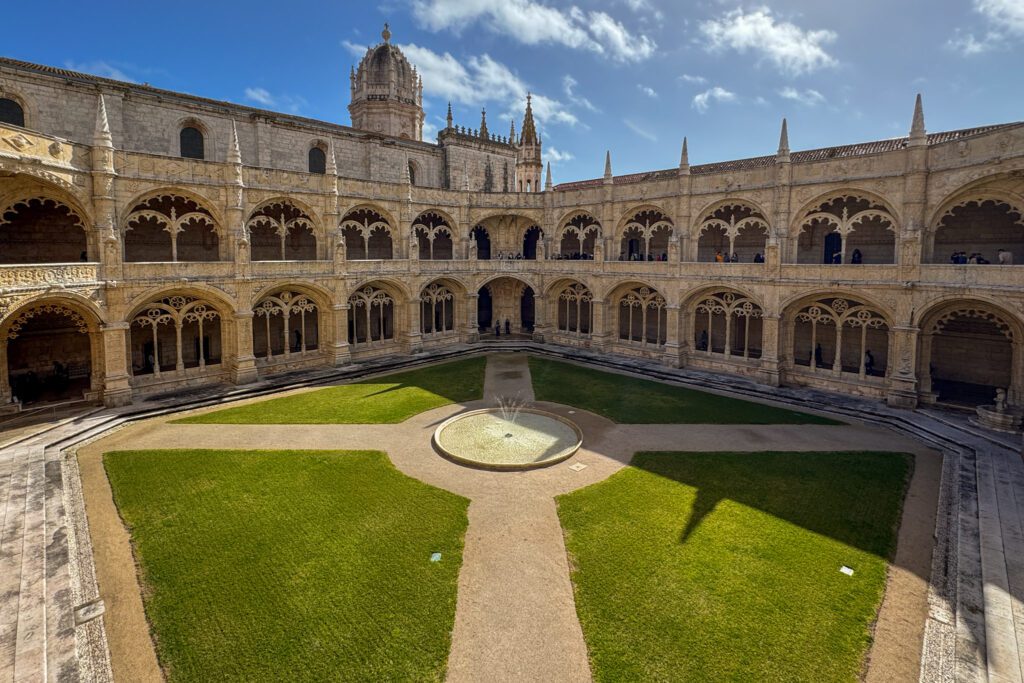
The big church you see from the tram is your next stop on your tour-de-Belém.
There are two pieces to this complex – the Igreja de Santa Maria de Belém (the church), which is free to enter and houses the tombs of Vasco da Gama and Luís de Camões, and the Jerónimos Monastery, which costs money and houses the beautiful cloister.
Construction started in 1501 and took over 100 years to complete, which should tell you something about the grandness you’re about to witness.
It’s a great example of typical Late Gothic Manueline architecture in Lisbon, which was created in the 16th Century during the Age of Discovery, and incorporates maritime symbols – ships, shells, and seas – into the more traditional Gothic style.
It’s typical in Lisbon, and there are a bunch of statues and examples of it around the city, including the statue of St. Vincent in Alfama, who is the patron saint of Lisbon and is holding a ship with two ravens (the coat of arms of Lisbon).
Like I said, elements alluding to the maritime history of Portugal are all over the place.
The church is free to enter, and you should definitely peek inside to see the grand scale and the two tombs.
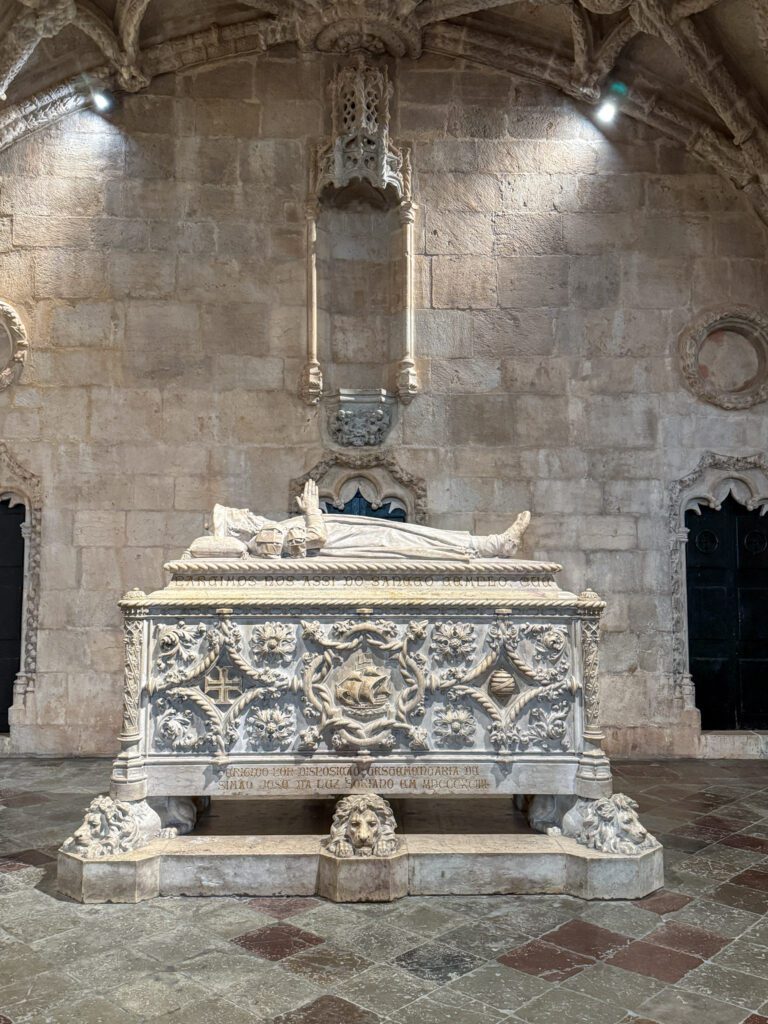
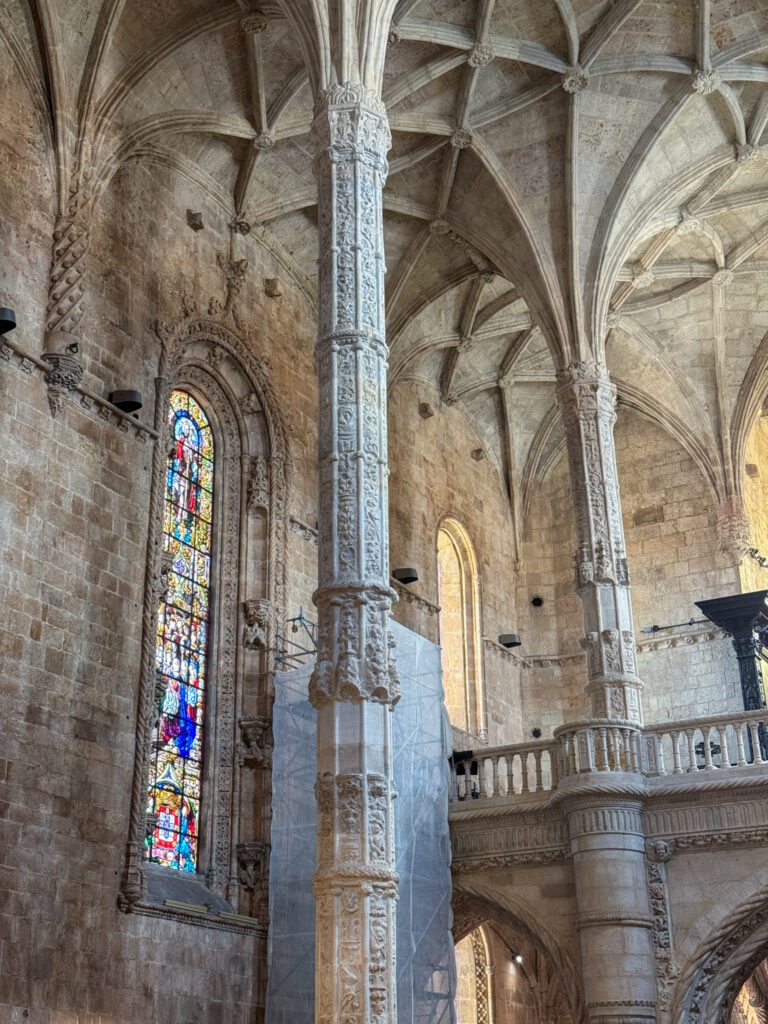
The cloister of the monastery is not free to enter – it costs €18, which is fairly pricey – but we do think it’s a cool illustration of the unique architecture you’ll find in Lisbon.
Until my latest trip to Lisbon, I had not been inside the cloister of the Jerónimos Monastery, which costs money to enter. On this latest trip, it was one of the main things I wanted to do while I was in Lisbon, and it did not disappoint.
However, depending on your interests, this might be something you choose to skip. The architecture is pretty cool, but if churches and architecture aren’t your thing, then I can see how you might walk away disappointed.
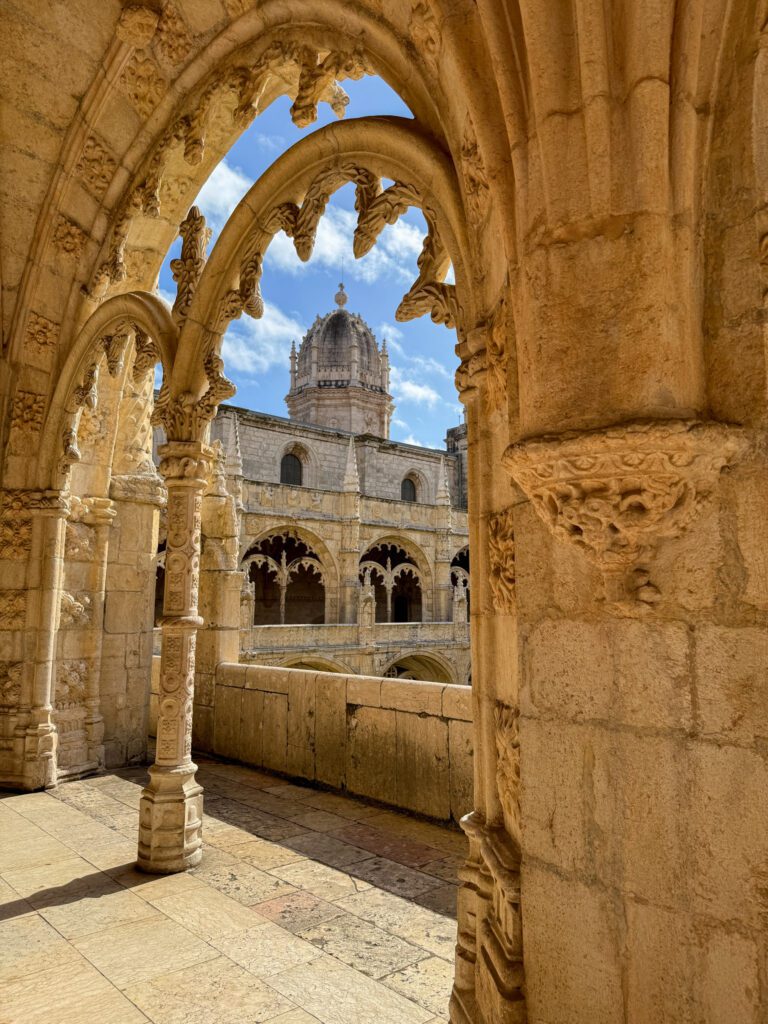
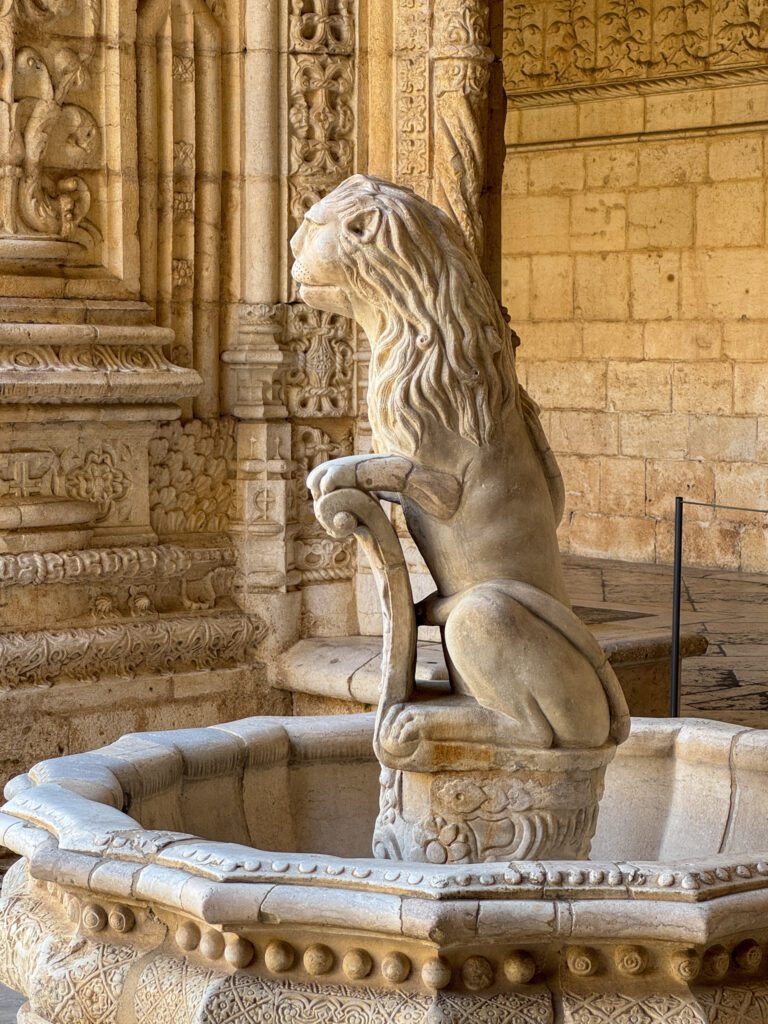
If you do want to visit the cloister, I highly recommend booking tickets – which means choosing a timeslot – in advance to skip the long line at the ticket office.
I actually had to come back a couple of days later because I thought “I’ll just show up and wait” only to find a LONG line snaking around the complex (I left, bought tickets for a couple of days later, and came back and walked right in with my pre-purchased ticket).
More information, including tickets, can be found here.
Pastéis de Belém
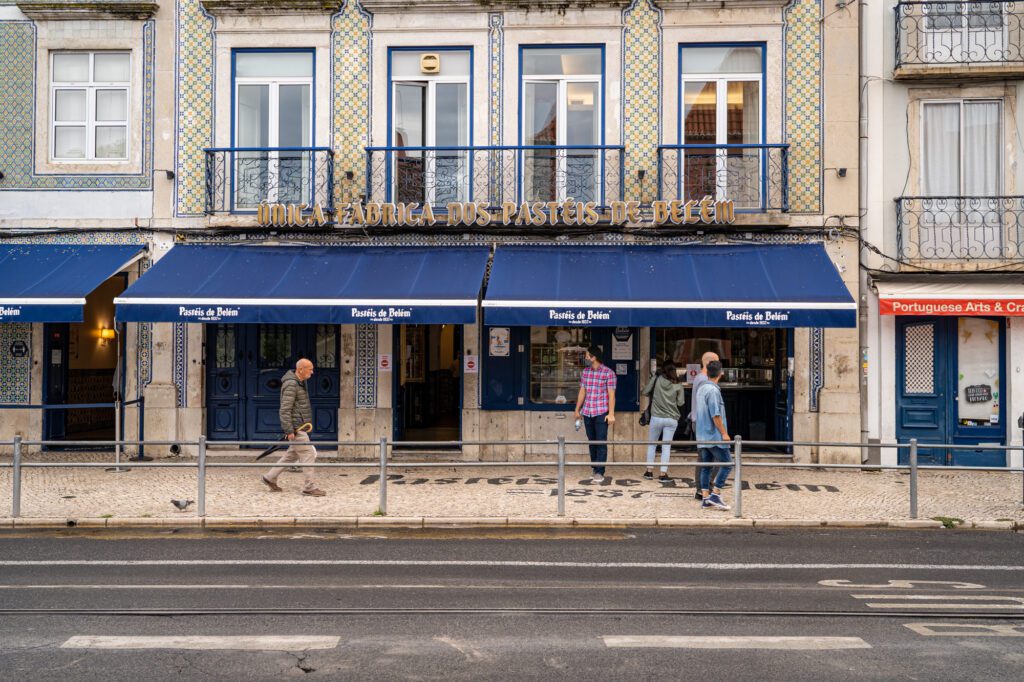
Head about a block east from the monastery to your final stop in Belém – the birthplace of the pastel de nata. Allegedly, anyway.
The legend goes that the pastel de nata was created by monks from the monastery wayyyy back in the early 19th Century. And the story is actually fascinating, and completely plausible.
Next to the monastery, there was a sugarcane factory, and after the revolution in Portugal in 1820, all convents and monasteries were shuttered in 1834, which meant that the monks had nowhere to go, and no way to make a living.
Before that, they bought A TON of eggs (the whites were used for starching robes) and found themselves with some leftover egg yolks, so they started making sweet treats as a little bit of a side hustle (and probably, more importantly, to enjoy themselves).
Ever the entrepreneurs, they sold that recipe to the pastry shop – the same one that exists there today – using that handy dandy sugarcane factory and those eggs.
Guess what the two main ingredients are in those pastries? Sugar and eggs.
They started pumping out these “Pastéis de Belém” – which would eventually become known more broadly as “Pastéis de Nata” – and two centuries later, the recipe and methods are said to be almost exactly the same as they were back in the 19th Century.
They’re so serious about their brand that only the pastéis that come out of this kitchen can legally be called “Pastéis de Belém” – the original.
Part of me wonders how much of that story has been romanticized over the years, and how similar the recipes really are today.
The other part of me says “yeah, that’s a good story, let’s go with that.”
But are they really the best? Here’s a completely subjective and unscientific take.
Everyone says to go here for the best pastel de nata you’ll have in Lisbon. So we put it to the test. And by “we” I really mean my two brothers and Alysha. No gluten for me.
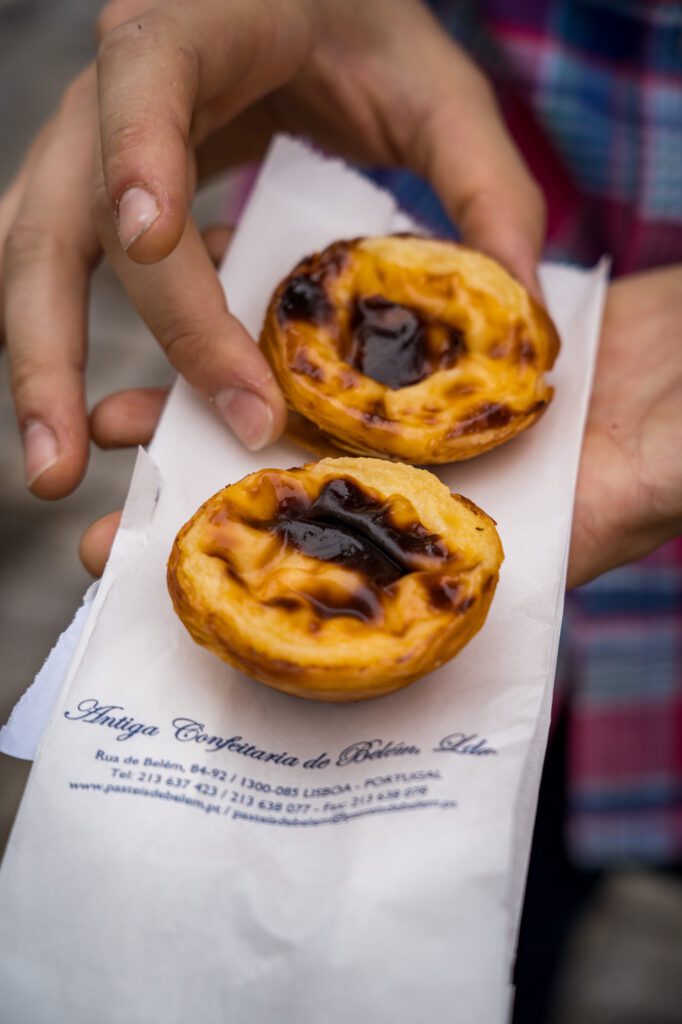

The results? This one came in second behind Manteigaria.
The crust was the best out of the three we tried, giving the pastry a nice texture contrast between the crispy outside and the ooey-gooey custard, but the custard was the downfall here, which was less flavorful than the ones they had tried previously.
Still, well worth a stop when you’re nearby. The more cinnamon, the better.
LX Factory (in Alcântara)
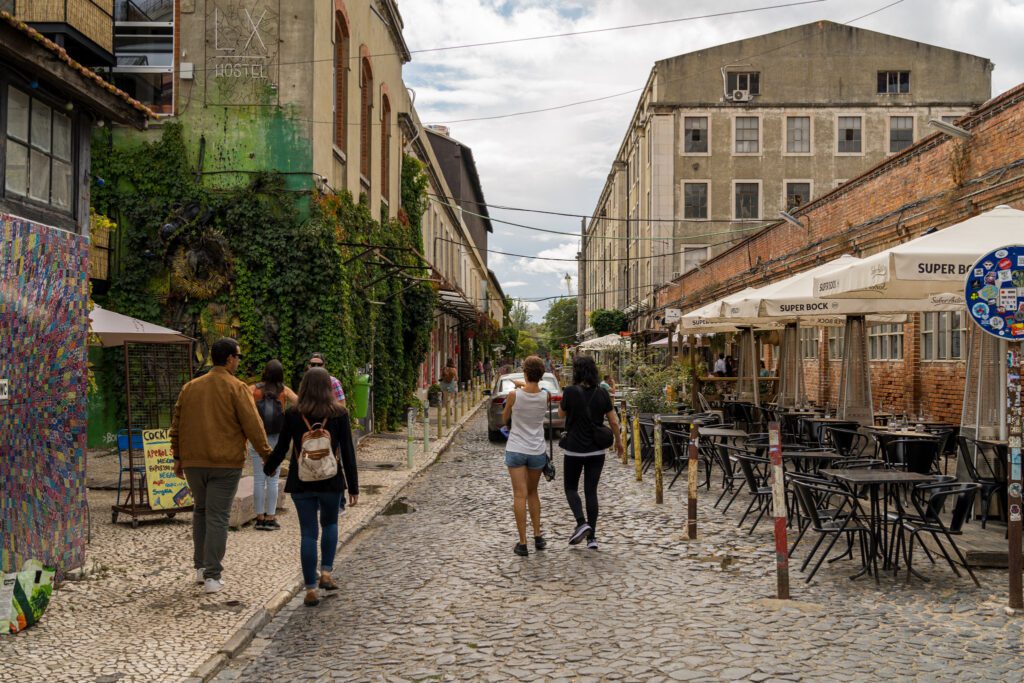
On your way back to the heart of Lisbon, make a pit stop in Alcântara to check out LX Factory, which is essentially right on the 15E tram line that you’ll take to and from Belém.
When you walk through the entryway here, you might feel like you’re in a hip part of Los Angeles or Brooklyn. And that’s kind of the vibe they’re going for, if we had to guess.
In the mid 19th Century, this area was home to an important textile factory. Which, as you might imagine, eventually shuttered thanks to globalization.
Today, it’s an outdoor hub of different shops, bars and restaurants, and small businesses who have all come together to create one of the most engaging, creative, and unique places in the entire city.
You’ll find a nice bookstore, a great wine shop, countless restaurants, and plenty more. Here were some of our favorite stops (though we think you should take your time and explore for yourself).
- Livraria Ler Devagar: You’ve probably seen this one on Instagram, with the big art fixture hanging from the ceiling of a person on a bike with their scarf trailing behind them. It’s a huge bookstore with a small English language section, a record shop on the first floor (that’s the second floor, to us Americans), and some cool old printing presses on the top floor that are worth checking out.
- More Than Wine: We found both wine and cider that we liked here, but they also sell things like chocolate, jam, honey, and ceramics.
We visited LX Factory in the morning, which we realized was not the right time to be there, and we ended up thinking to ourselves “I bet this place would be cool later.”
Seek Out the Best Views in Lisbon
Kind of like San Francisco, which is where we lived and met over a decade ago, Lisbon is a city of hills. Which means there are incredible views to be had from atop said hills.
Sure, it’s usually going to take some effort – there were multiple points where we were sweating profusely in search of a great view – but once you’re at the top, the reward is worth the effort.
There are three viewpoints in Lisbon that stand out to us as worth prioritizing.
First is our favorite view of the city – Miradouro da Senhora do Monte (which you can find here on Google Maps).
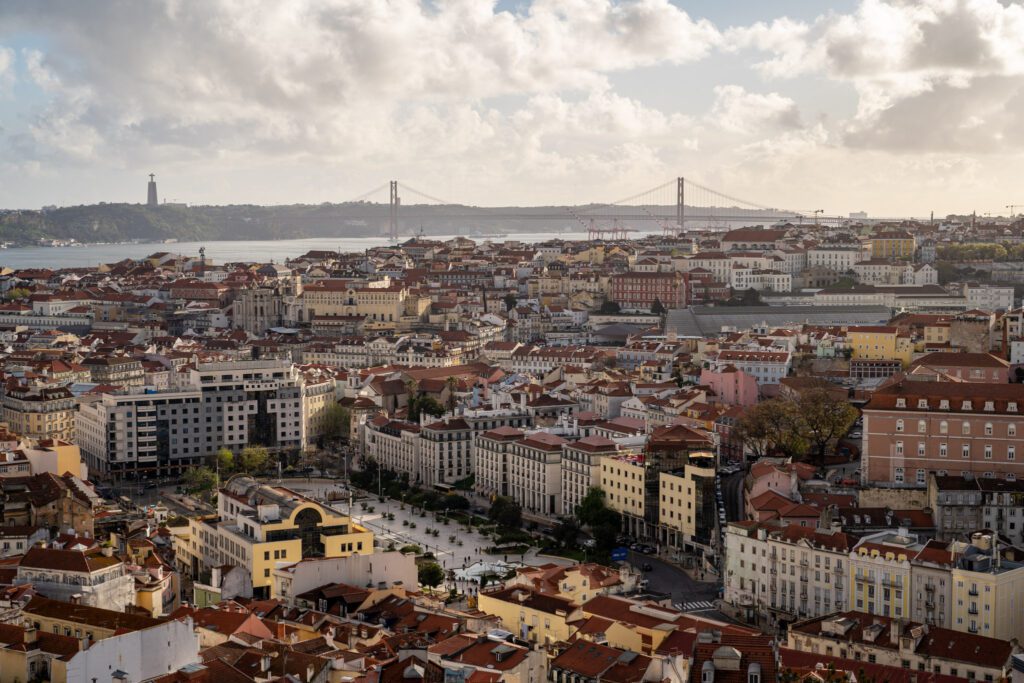
This view includes the Castelo and hill that Alfama sits on along with the river in the distance and the oval-shaped Praça Martim Moniz in the foreground.
It’s a bit of a trek to get up there – and the public transit options are somewhat limited – but it’s well worth it.
There are a couple of things worth checking out nearby that involve beverages, namely the craft brewery a few blocks below (8a Graça – here on Google Maps) and Lapso Specialty Coffee Bar (here on Google Maps).
It’s also worth stopping by Miradouro da Graça (here on Google Maps) on the way up or down, though the view isn’t quite as nice as the one from further up the hill.
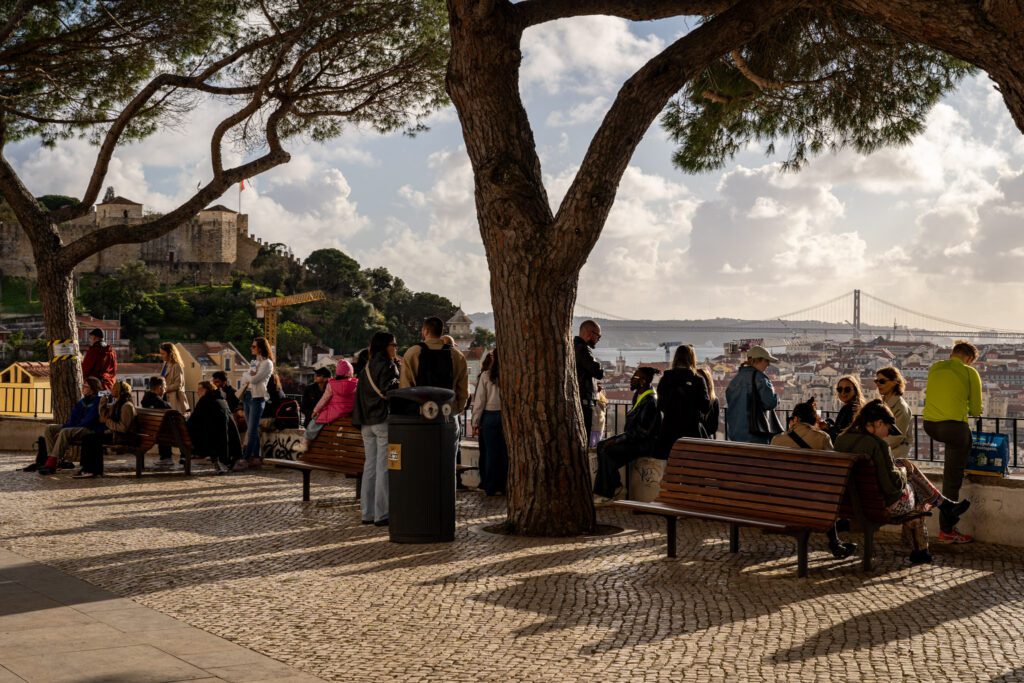
The second viewpoint is actually a couple of views within a couple of blocks in Alfama.
The two viewpoints are Miradouro de Santa Luzia (here on Google Maps), which looks southeast out over the river and the sprawl of Alfama down the hill, and Miradouro das Portas do Sol (here on Google Maps).
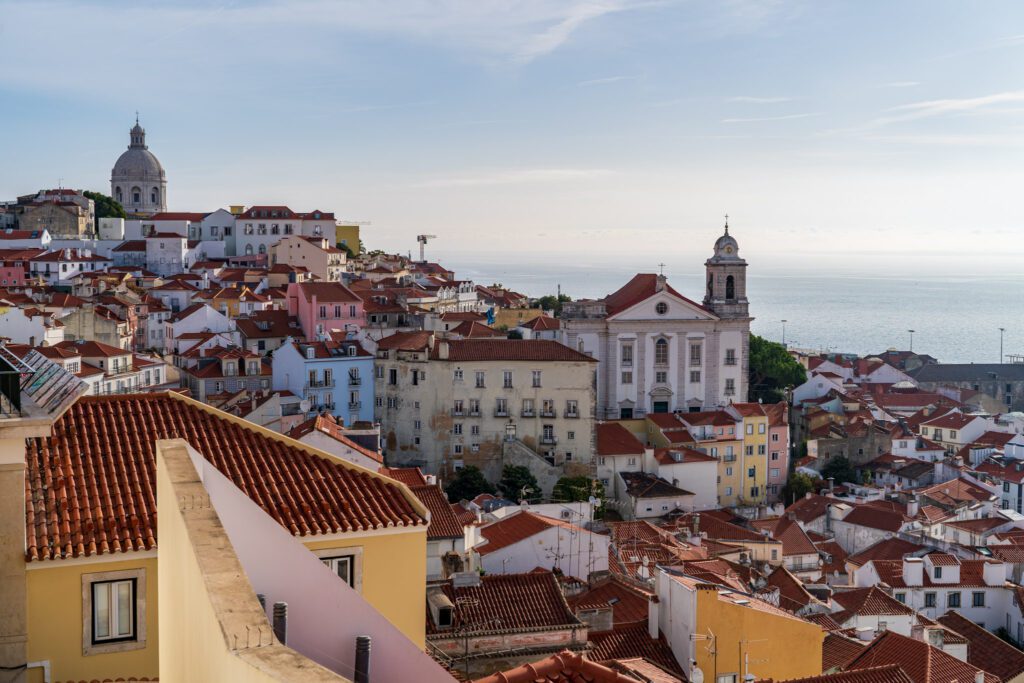
Again, there are a couple of spots worth stopping by right near these views.
We love Miss Can for their sustainable tinned fish (we bring back a bunch whenever we’re in Lisbon), and they have a restaurant right up the hill from Miradouro de Santa Luzia.
There’s also a great work of street art that depicts the history of Lisbon in a passageway under a set of stairs here on Google Maps that’s worth a quick stop.
And while the quality of drinks isn’t going to be perfect, we also think a stop at Quiosque das Portas do Sol (here on Google Maps) for a drink or coffee is worth the price for the view you get from the terrace.
The last viewpoint we like is from across the valley from the other two at Miradouro de São Pedro de Alcântara (here on Google Maps).
Here, you’ll find a great view that is more accessible from central Lisbon and also has a nice little guide to the various hills and landmarks you can see.
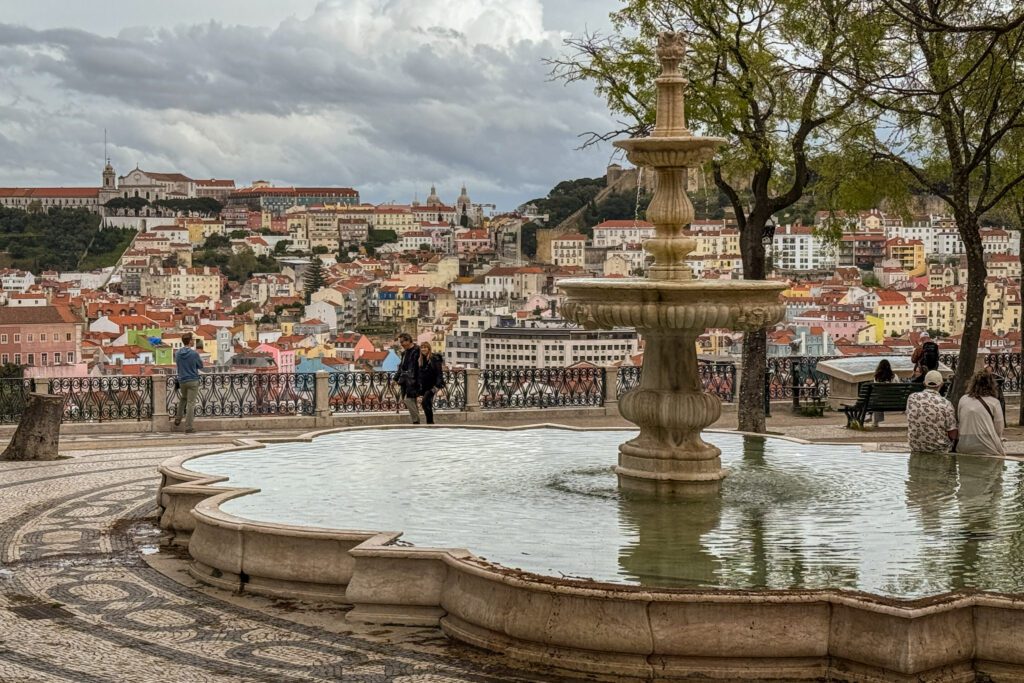
Explore Lisbon’s Coolest Neighborhoods
Unlike, say, Paris or Rome, Lisbon isn’t a city that is packed full of too many tourist attractions to realistically fit into a trip.
Instead, there are a few key things to see, and then the rest of your time should ideally be spent wandering the various neighborhoods around Lisbon.
We’ve already covered Belém, which is a 30 minute tram or bus ride west of the city center, but there are three other neighborhoods we’d recommend spending time in while you’re in town.
Those three neighborhoods are:
- Chiado, the historic, opulent neighborhood that was frequented by artists and writers
- Alfama, the historic neighborhood with character, views, and Roman ruins
- Bairro Alto, the nightlife hub at the top of one of Lisbon’s two central hills
Of course, there are other places to hang out – like Alcântara and Graça – but this is a good starting point (we think).
Chiado
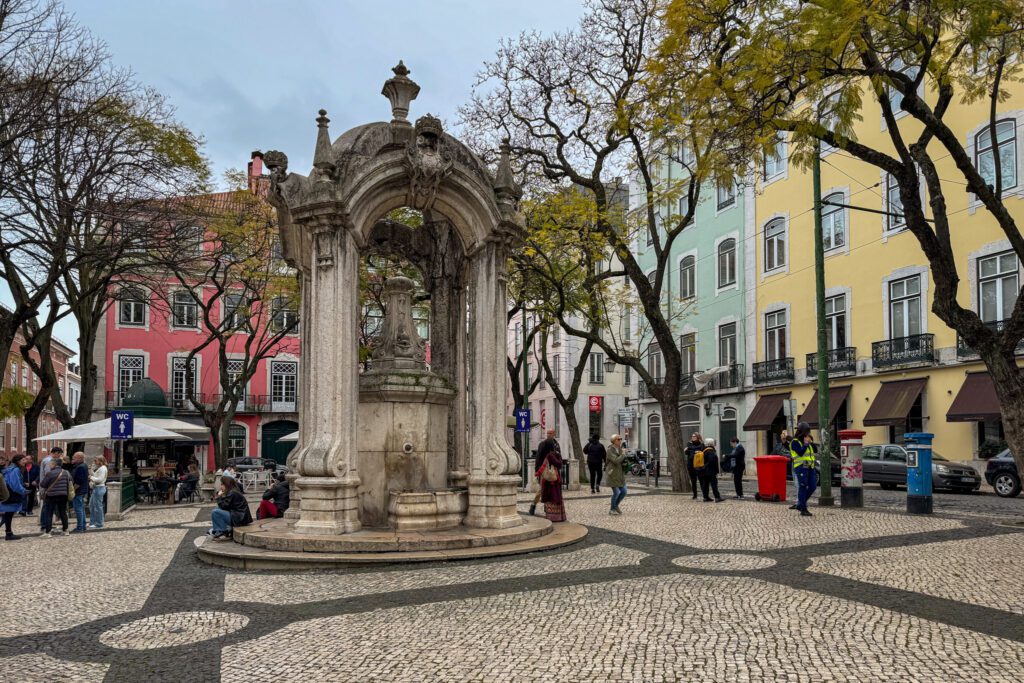
Chiado is the area on the slopes of the hill to the west of Baixa, and is the part of the city that drew writers and other intellectuals (like Luís de Camões, the most famous Portuguese poet, who has a plaza in Chiado dedicated to him).
Today, it’s caught between the modernity of Baixa and the charm of Bairro Alto, and you’ll find good shopping, great views, and some important elements of Portuguese history.
There are a couple of ascensores (which are funiculars, kind of like a cable car) – you can find them here and here – that can help you climb the hill if you have mobility restrictions, but we’d recommend walking if you can because there are some great views to be had from random streets atop the hill.
Something like this route would be a perfect start to an epic afternoon full of great views from Lisbon’s many hills.
Along the way, there are several stops worth making. Here are some of our favorites in the order you’ll encounter them if you follow our advice.
O Trevo: If you’ve never had a bifana, the famous sandwich made with pork cooked in a big wide vat (or just a big stainless steel pot), this is one of the best places to try one in Lisbon.
There are some good spots in Porto, too, where the style of sandwich is slightly different (My source? Anthony Bourdain and a couple of walking tour guides who I asked).
It doesn’t look like much – it’s truly just the pork served on a soft roll – but it’s a quick and easy snack that my brother enjoyed (too much gluten for me, too much pork for Alysha).
A Brasileira and Livraria Bertrand: Two relics of Portugal’s literary history. A Brasileira is a cafe that was the favored haunt of Lisbon’s well-known intellectuals (there’s a statue of the famous poet Fernando Pessoa outside) that would be a great spot for a quick coffee. Livraria Bertrand is (allegedly) the oldest bookstore in the world.
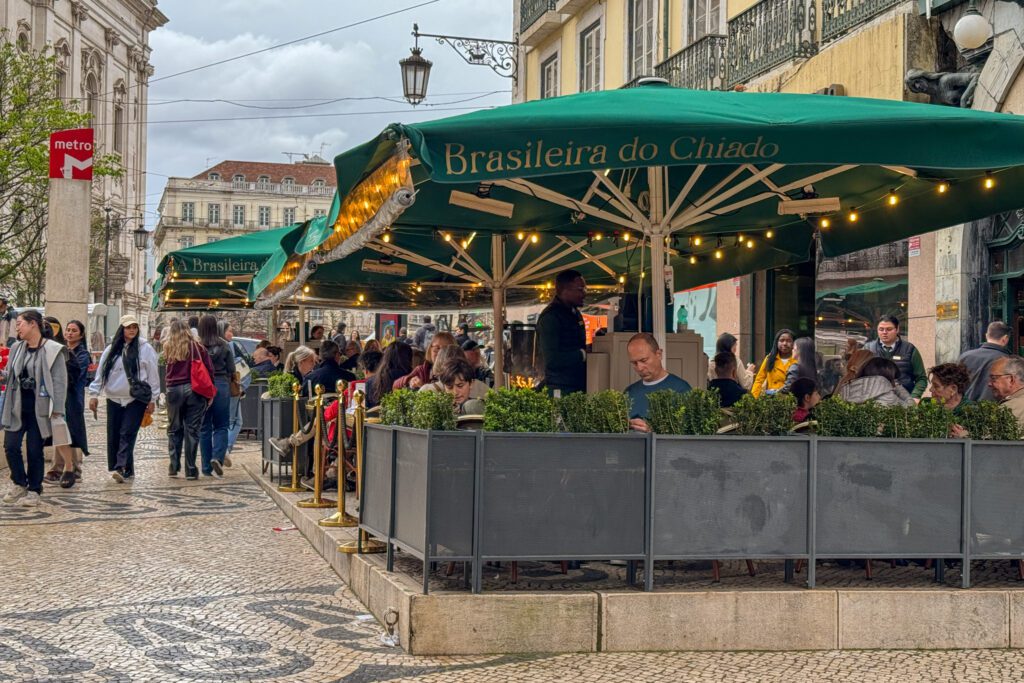
Convento do Carmo: It’s not worth going inside, I think (it’s just a big collection of artifacts with very limited storytelling or even relation to the building itself) but it’s a reminder of the devastation that hit Lisbon in 1755.
The square outside is also the location of the culmination of the Carnation Revolution that (peacefully) ended the Salazar dictatorship and brought democracy back to Portugal (the headquarters of the equivalent of the National Guard is next to the convent).
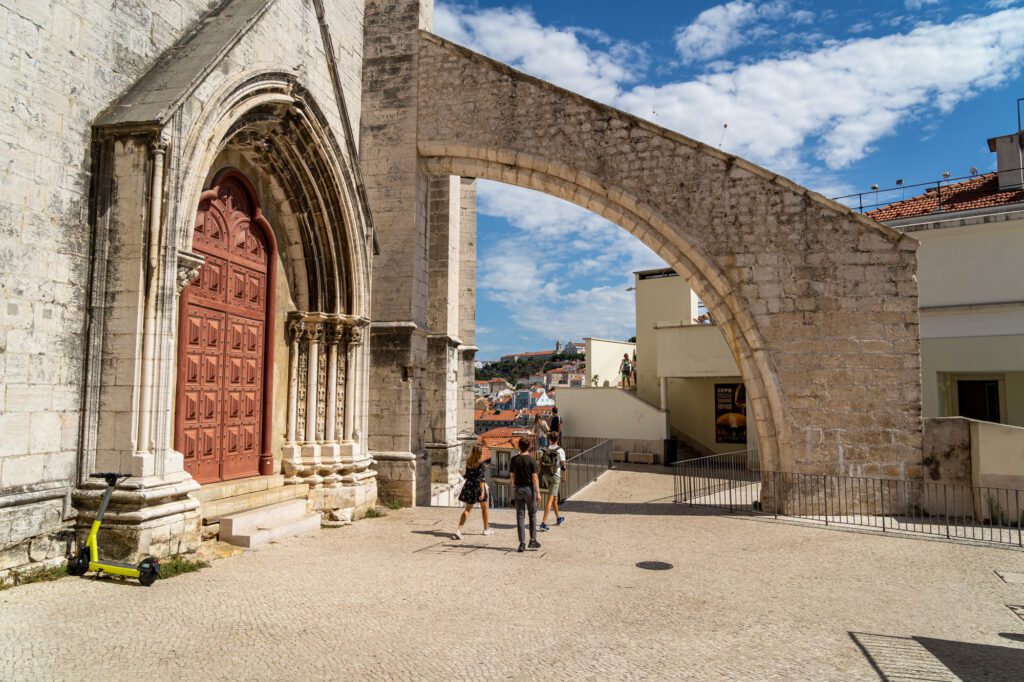
Elevador de Santa Justa: This cast iron elevator brings people from the streets of Baixa up the hill to Chiado, but the lines are long and it’s a short walk to cover that same ground.
Our recommendation is actually to see it from the bottom, then walk around it up the hill and then see it from the top (or vice versa) rather than actually riding it.
It features long lines and high prices, and this is a good way to save both time and money.
Alfama
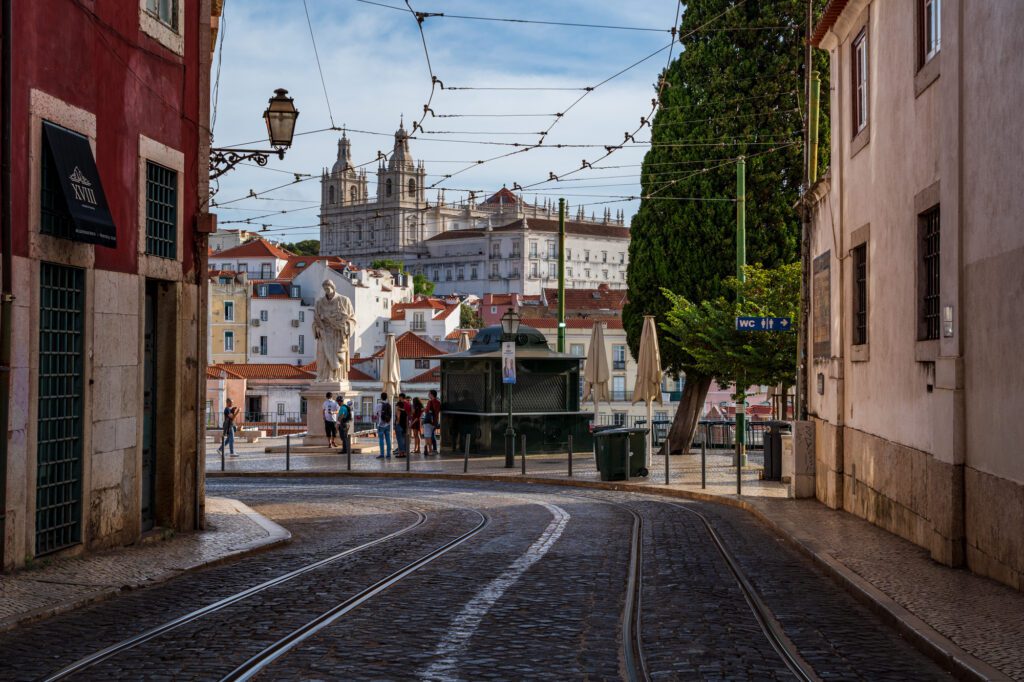
Alfama is the most romantic slice of central Lisbon. It is the oldest feeling part of the city, with narrow cobblestone streets that wind their way down from the Castelo de São Jorge at the crown of the hill.
It’s also home to several of the best viewpoints in all of Lisbon, which you should definitely make an effort to get to.
Lisbon is very much a city that’s made for wandering, and there is no better neighborhood to get lost in than Alfama.
In addition to the old feeling you get here, with streets crafted well before the invention and adoption of the car, it’s also actually one of the oldest parts of the city, evidenced by the presence of a Roman amphitheater that has been uncovered under the modern streets (which you can see today).
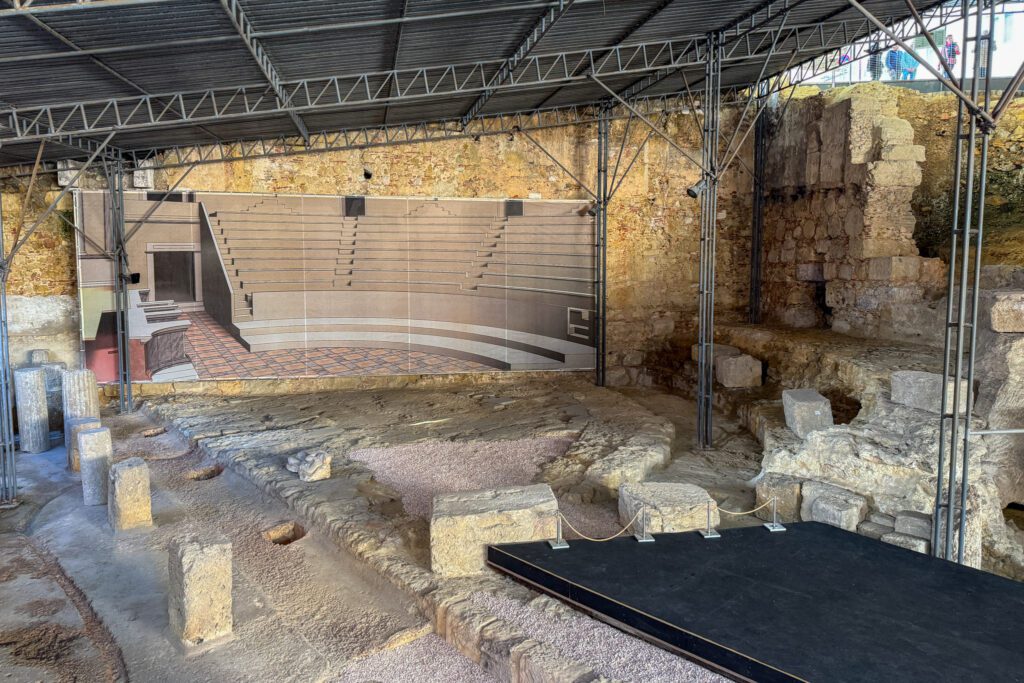
The castle that’s visible from the lowlands – Castelo de São Jorge – sits at the top of the neighborhood (though there are better views to be had from a short walk up the hill!), and has served many purposes over the 18 or so centuries that the fortifications have existed here.
It’s a good illustration of Lisbon’s history because every Mediterranean power that has occupied this land – from the Phoenicians, Carthaginians, and Romans, to the Islamic Caliphate that existed in southern Portugal for centuries and the present day Portuguese – set up shop here at the top of the hill.
It is worth noting, though, that the castle fell into disrepair after the earthquake in 1755 and was only restored in the 20th Century under the dictatorship as a symbol of the golden age.
Anyway, all that is to say that Alfama is well worth a half day or so of your time, but the question of whether you should stay there is a bit more complicated.
It’s charming. It’s romantic. It’s a fun place to eat and drink (especially if you include nearby Graça, which is a great place to both wander and eat).
Here are a few suggestions of things to do and see in Alfama. My advice is to start near the top of the hill with the castle, then make your way downhill from there to the Lisbon Cathedral (Sé de Lisboa).
You can ride the 28 tram up the hill and walk back down if climbing up to the castelo on your own two feet doesn’t sound like your idea of fun.
Castelo de São Jorge: The castelo sits on top of the hill, with Alfama sprawling down the hill from its walls towards the river.
It used to be an important defensive position, and was the scene of many battles over the centuries before the Portuguese took Lisbon and established it as their capital.
Since then, it has been many things, including a hospital and a prison, and only in the 20th Century was it restored to its former glory.
Today, you can visit the grounds (it costs €10) and, most importantly, walk on the castle walls for some amazing views. More information here.
Miradouros Galore: There are several great viewpoints in Alfama, including two that are just a few blocks away from each other.
- Miradouro de Santa Luzia (here on Google Maps) is the first, and it’s a nice view out towards the river. There are some cool tiles to check out on the side of the Igreja de Santa Luzia (right next to the viewpoint) depicting a battle for the Castelo.
- Miradouro das Portas do Sol (on Google Maps here) is the second, which has even better views out towards the Tagus River, including the Igreja de São Vicente de Fora out to the northeast on the hill.
Don’t miss the statue of St. Vincent, the patron saint of Lisbon. The latter viewpoint has a nice little outdoor terrace with a bar, which would be a lovely place to enjoy, say, an Aperol Spritz or a Port Tonic while watching the sun’s golden glow light up the hillside.
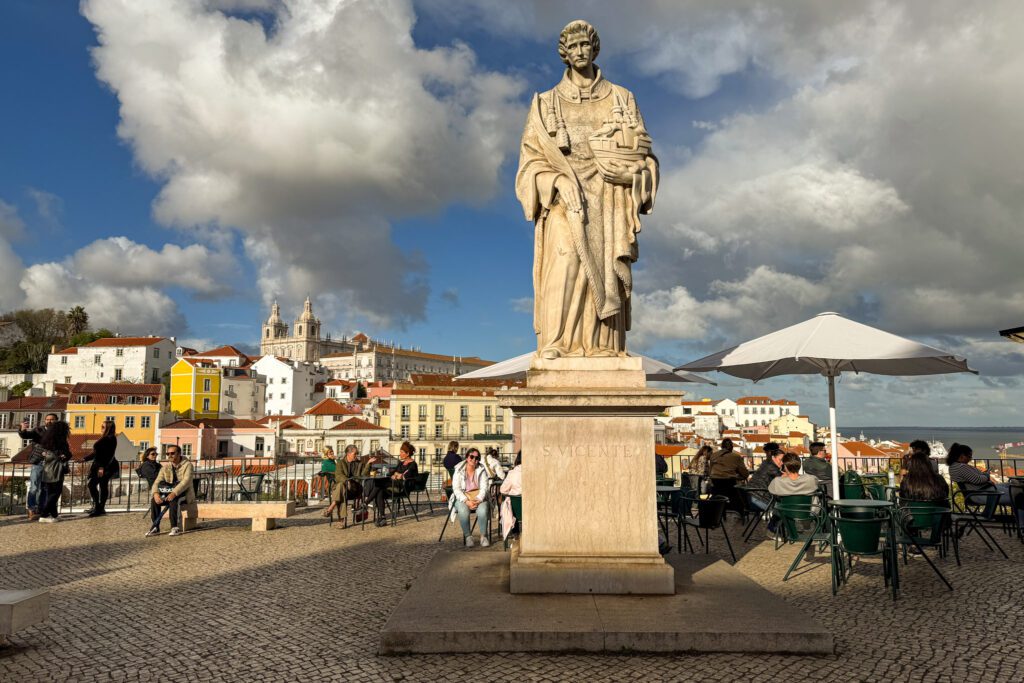
Miss Can: When in Lisbon, you should try canned fish at least once, even if you’re not sure it’s your thing. And we think Miss Can is the place to do it.
It’s owned by a woman whose family has been in the fishing industry for generations, and she does the work to ensure her product is sustainable, from the fish to the cans.
We tried a bunch, and really, really liked the bacalhau (that’s cod) in garlic and olive oil. It was the least “fishy” option if you’re not a huge fan of fish flavors. You can either enjoy it at the small restaurant, or pick up some cans to try later.
They also make great souvenirs to bring home for friends and family. On our return trip to Lisbon a few months after our first visit, we came back and bought about seven cans to bring home to friends, all of whom absolutely loved them (and some even ordered their own to ship all the way to the United States).
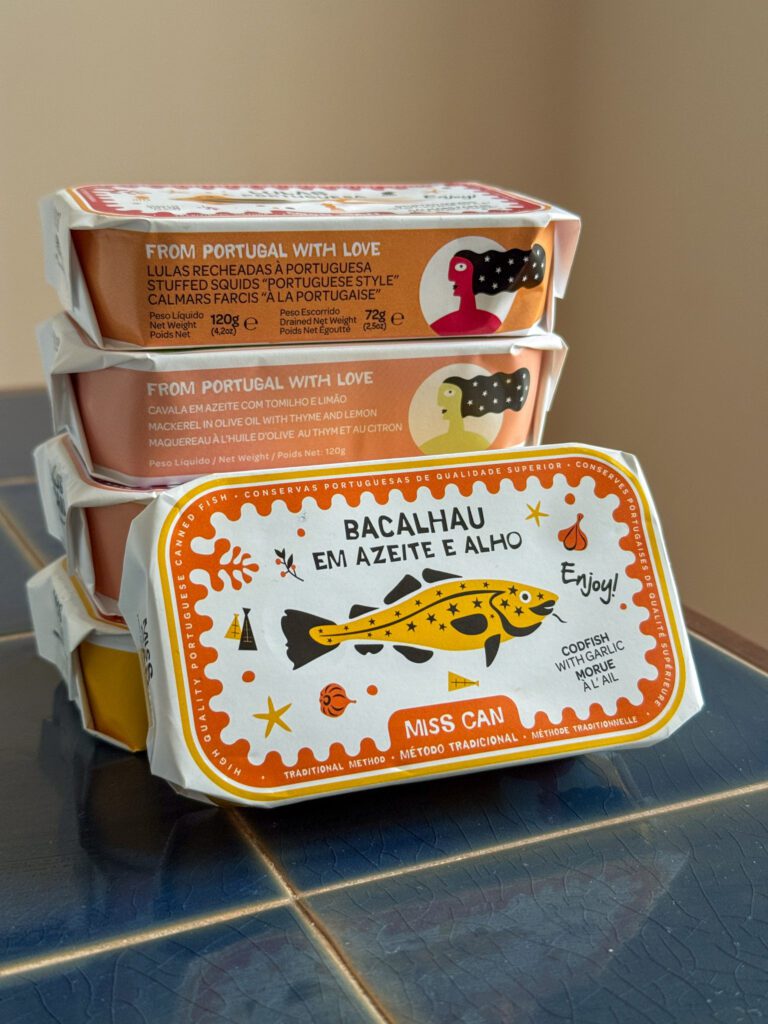
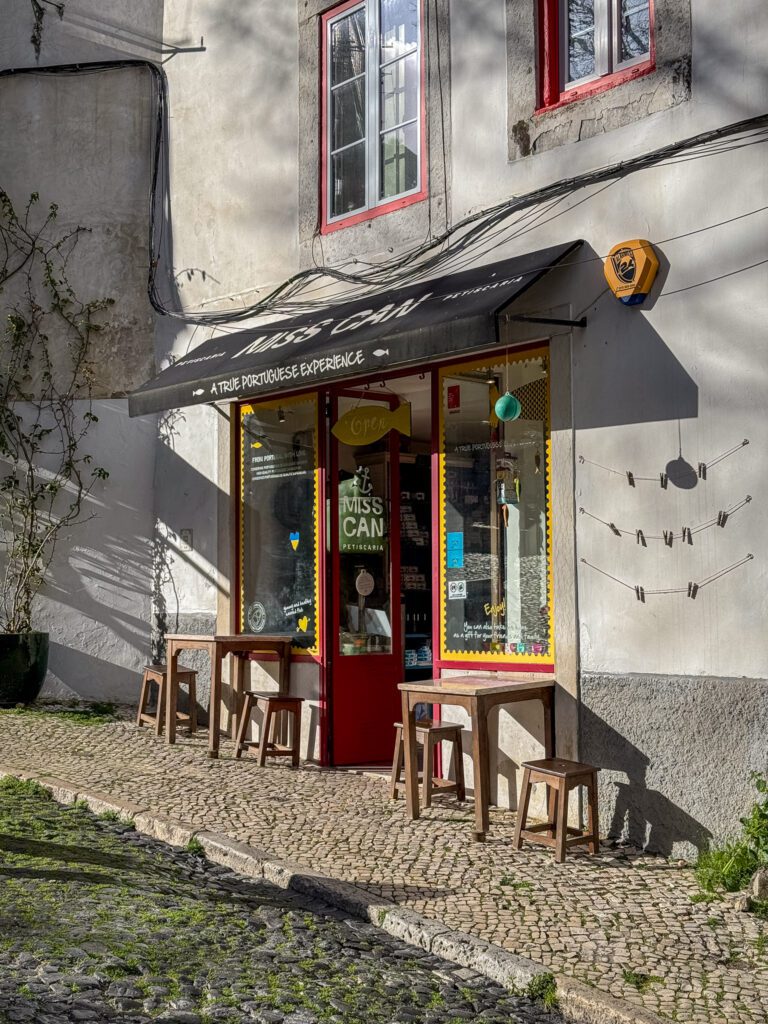
Alfama Cellar: This is another place that was recommended to me partially because they can do gluten free food, but I didn’t make it here on my last trip. Their seafood rice (in my mind, the Portuguese version of paella, sort of) is the thing to try.
Bairro Alto
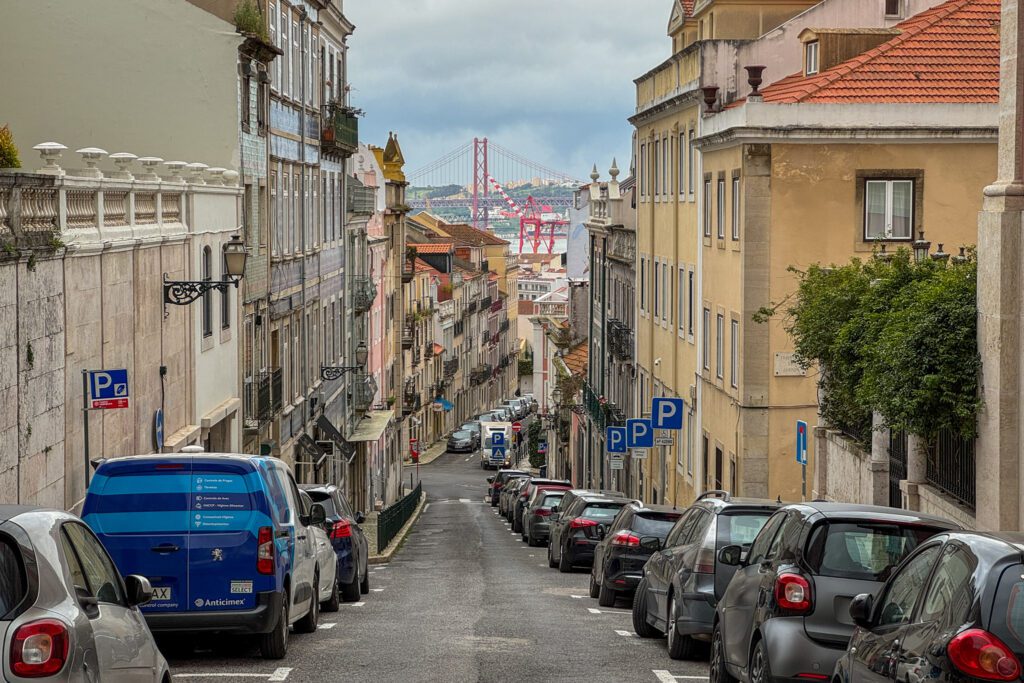
Bairro Alto is perched at the top of the hill above Chiado, which means the views around every corner are pretty spectacular. It literally translates to “high neighborhood” (or something to that effect).
In a lot of ways, it reminds us of Nob Hill in San Francisco, which is the neighborhood in which many of our personal relationship milestones took place (we met in Nob Hill, moved in together in Nob Hill, and made the decision to bet it all on this website in Nob Hill).
On my last two trips to Lisbon, this has become my personal favorite neighborhood to explore; First of all, note the spelling (it’s “Bairro” not “Barrio”).
Bairro Alto is immediately adjacent to Chiado, and has roots dating all the way back to the 16th Century, when the grid was first laid out and buildings started to be built.
This part of Lisbon saw fewer devastating effects from the earthquake than other parts of the city, but Pombal and the Portuguese government took the opportunity to strike when the iron was hot and modernize the infrastructure in Bairro Alto in the period where the rest of Lisbon was being rebuilt from the ground up.
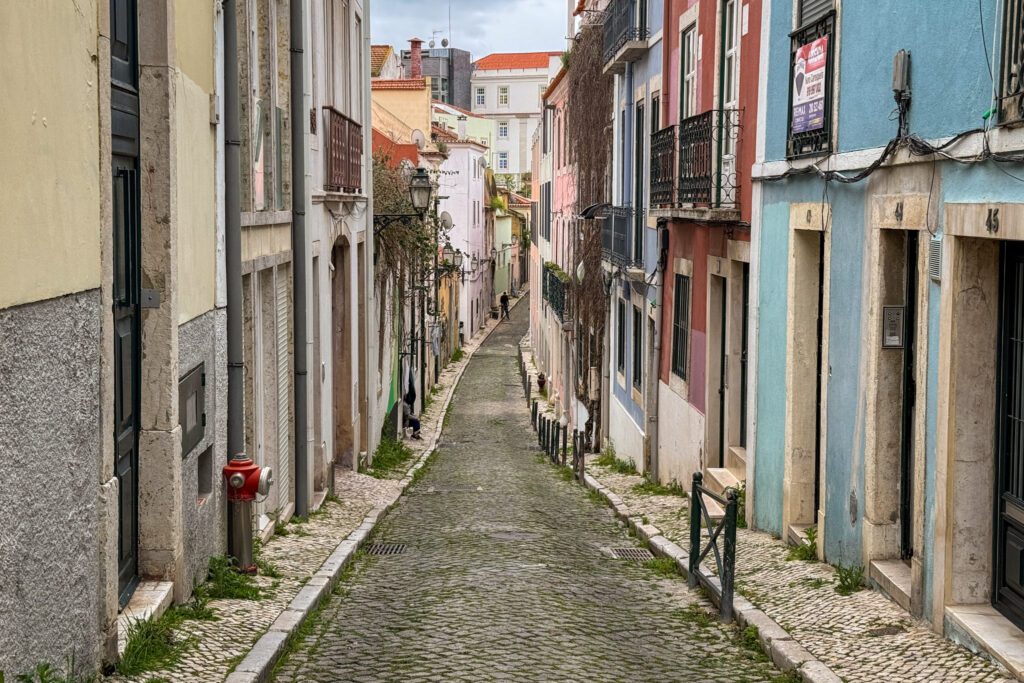
Today, Bairro Alto is a nightlife hub, and is full of bars, clubs, and restaurants of all kinds.
Packed nearly wall to wall with tourists and locals alike who are enjoying their drinks in the middle of the street (at least in the warm and mild months…so, like, 10 months of the year?), Bairro Alto comes alive when the sun goes down.
From wine bars to speakeasy cocktail bars to nightclubs that don’t close until the early morning, you’ll find the best nightlife in the city here.
It’s on top of one of the city’s tallest hills, it has great views in every direction, it’s a mix of residents and visitors, and it’s full of great places to eat and drink.
There aren’t really any big tourist attractions here, so this list is basically just a list of places to eat and drink in the neighborhood.
For the purposes of this guide, we’re going to combine the adjacent neighborhood, Principe Real, with Bairro Alto to form one super-neighborhood with some of the best food and drinks in the city. We’re not convinced that anyone, local or tourist, really views them as completely separate, anyway.
Miradouro de São Pedro de Alcântara: A nice viewpoint that is easily accessible from central Lisbon that has a nice little guide to the various hills and landmarks you can see out to the northeast.
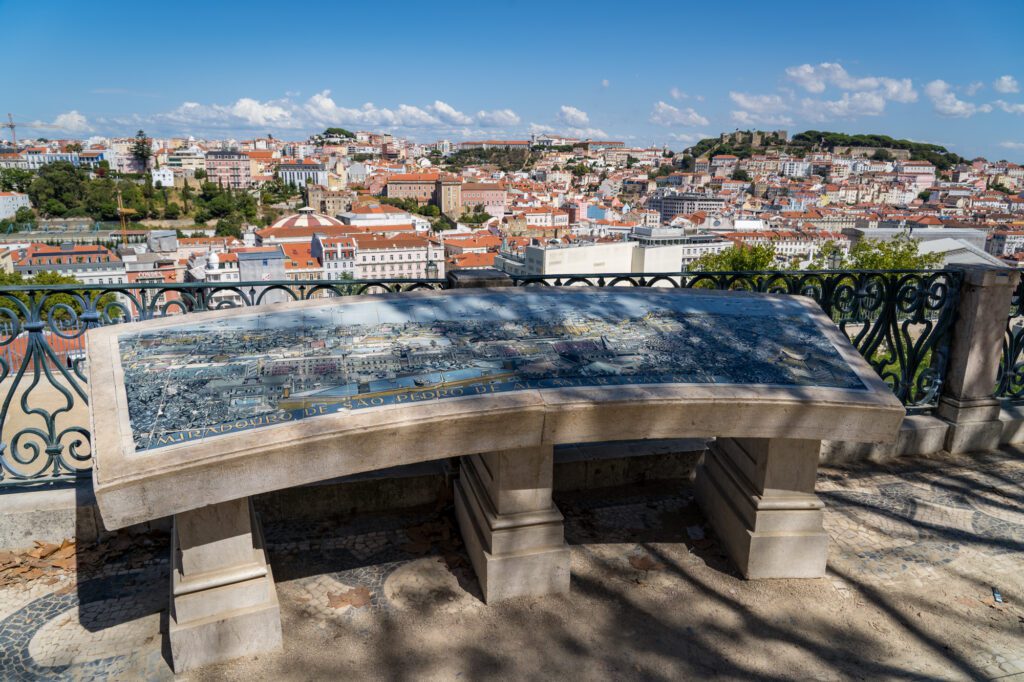
Dramático: My favorite coffee experience in Lisbon on this past trip, I wandered here on a sunny morning and found a tiny little coffee shop tucked in an oddly shaped space (it’s triangular?) with a friendly owner-barista (the best kind!) and just a few tables.
As I sat there furiously taking notes on my past 12-24 hours of activities, a steady stream of people came in. Some just wanted a flat white to go, some sat down and enjoyed their coffee and a pastry while combing through one of the stylish magazines.
Great coffee, great vibe, and great owner who was more than happy to talk nerdy to me about the coffee aspect.
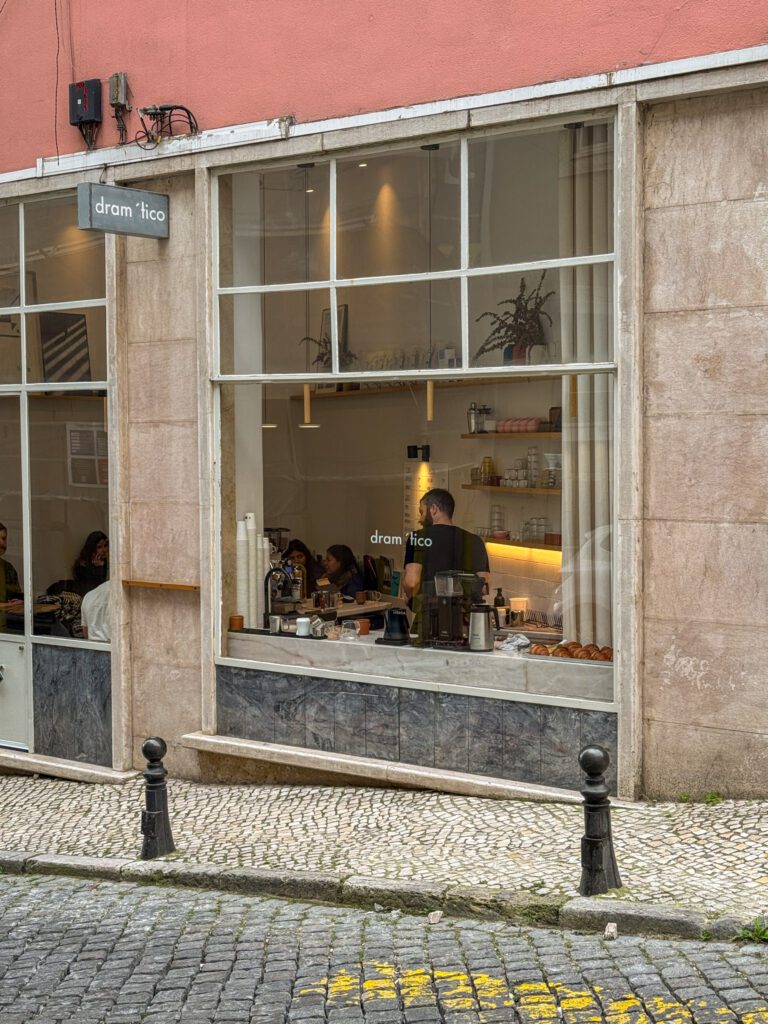
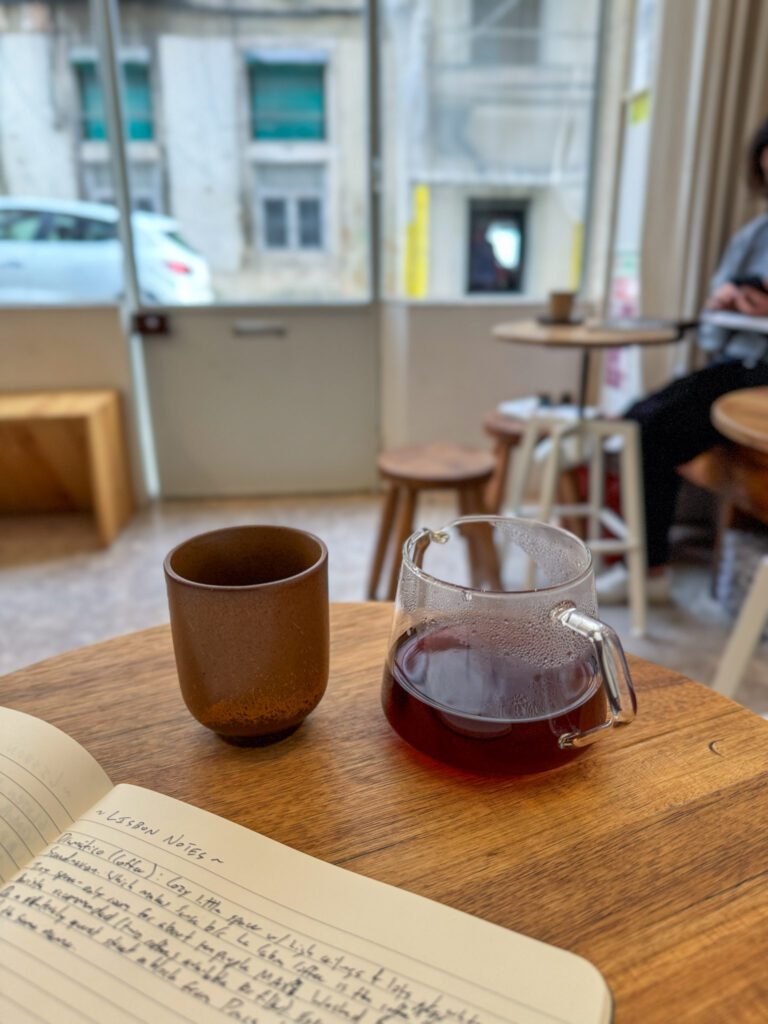
Jobim: A lovely little wine bar about three blocks west of Jardim do Príncipe Real with a mix of Portuguese and Brazilian food and good vibes for a night out.
Black Sheep: My favorite wine bar in Lisbon! It’s tiny, and I tried to come here twice on our first stint in Lisbon, but they were closed for various reasons every time (family vacation and staff parties, etc etc).
Finally, we made it here on the third try when we looped back through Lisbon at the end of that trip, and they were so friendly and helpful.
It’s a very intimate space, but they’re more than willing to help you find a wine you like and chat about Lisbon, wine, and just about anything else (even cider!). The menu constantly rotates, so there’s always something new to try.
Jardim do Príncipe Real: The top of the hill! Or close to it. I met Humberto, my guide for the LisboaLove walk I did on my last trip to Lisbon, here. As I was waiting for him, I was enamored by the views from the streets at the south end of the garden and the massive cypress tree with an elaborate trellis supporting it.
Walk the Walls at the Castelo de São Jorge
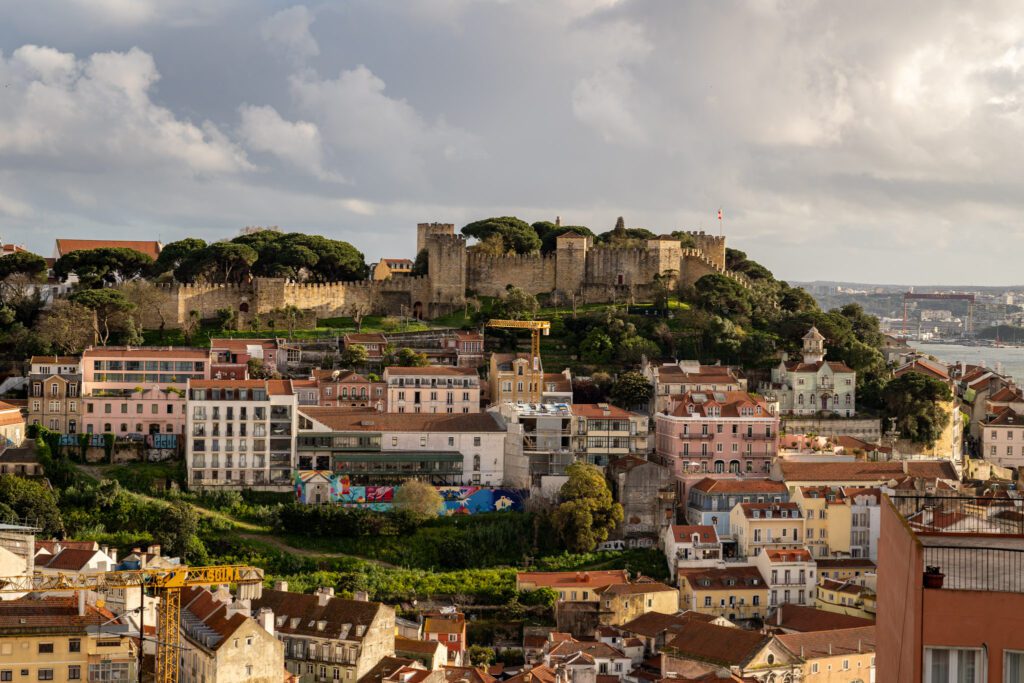
The castle that’s visible from the lowlands, Castelo de São Jorge, sits at the top of the neighborhood (though there are better views to be had a short walk up the hill!), and has served many purposes over the 18 or so centuries that the fortifications have existed here.
It’s a good illustration of Lisbon’s history because every Mediterranean power that has occupied this land – from the Phoenicians, Carthaginians, and Romans, to the Islamic Caliphate that existed in southern Portugal for centuries and the present day Portuguese – set up shop here at the top of the hill.
It is worth noting, though, that the castle fell into disrepair after the earthquake in 1755 and was only restored in the 20th Century under the dictatorship as a symbol of the golden age.
The castle started its life as a defensive fortress to help protect the city from invaders. It’s also been used as a royal palace, military barracks, hospital, and prison over the years.
In the 20th Century, the castle underwent a huge renovation project to bring it back to its former glory.
While there’s not much to see inside the castle itself these days, the fortress walls boast fantastic panoramic views over the entire city, which are more than worth the €10 entry price alone.
You can also visit the camera obscura and explore the many hidden pathways winding through the castle grounds.
Dive Deeper into Lisbon’s Food Culture
Over the years, we’ve realized that one of the best ways to spend a few hours learning more about a city and its history is by…eating?
Seriously though, the food culture of a city tends to be extremely revealing, and it’s a fun (and delicious) way to experience a place.
Diving into the food culture in places we’re visiting is one of our favorite aspects of traveling, and we try to include a food tour, cooking class, or market tour in most places we visit.
The food of a place tells you so much about the culture, history, and influences that have shaped the city you’re exploring today, and exploring a city through its food scene is a unique perspective that a lot of people don’t even consider.
Unfortunately, the reality is that because Matt has Celiac Disease and can’t have even a speck of gluten without being sick for days, a food tour or cooking class usually isn’t in the cards for us.
HOWEVER. That does NOT mean it shouldn’t be for you!
We’d highly recommend it because it gives you a local’s perspective on the city’s food scene – what and where to eat and drink – and you get to connect with fellow travelers and try some amazing food.
Here are some options for you – one food tour and two cooking classes – that have been on our list but can’t accommodate Matt’s gluten-related needs.
Our bias is to do a cooking class because we LOVE to cook, but we also enjoy a good food tour.
If you want to do a food tour, this is the tour we’d recommend, though (disclaimer) we haven’t done it ourselves. It’s a four hour journey through Alfama with 18 tastings over many stops as you make your way through the most charming neighborhood in Lisbon (we think).
Catch the 3pm tour and show up hungry. Seriously. Don’t eat beforehand.
If you want to do a cooking class, there are several directions you could go; focusing on a specific item (in this case, it’s the pastel de nata) or focusing on a broader look at Portuguese cuisine.
Depending on what you’re looking for, we had bookmarked these two tours for our own trip (though obviously the pastel de nata class is problematic for the whole gluten thing): this class focused on pastéis de nata or this cooking class that focuses more on main dishes.
See the City from the River at Sunset
Look, I too was skeptical of boat trips catering to tourists.
However, after a (life-changing, sort of) early morning canal cruise in Amsterdam – another city whose history is intrinsically linked with water – I have come around to the idea that it is absolutely worth seeing a city that is shaped by water from that water.
In this case, the water that shaped Lisbon is the Tagus River (also called the Tejo), which serves as its connection to the Atlantic and was the lifeblood of Portugal’s economy for centuries.
There are a wide variety of different river cruises available, ranging from bigger boats with DJs and bottomless drinks to smaller sailboats with more intimate groups, and as we were researching options we were drawn to the latter category.
There are a couple of tour options that we came across, and the key to look for is a sunset tour with a small Portuguese-run company, which will give you the best experience and help you see the city through a different perspective, both literally and philosophically.
The option that came to the top as we were searching is this sunset sailboat cruise, which is a small group (max of 10), is run by a group of Portuguese sailors, and covers a nice little loop out on the river.
Visit São Vicente de Fora Monastery and Church
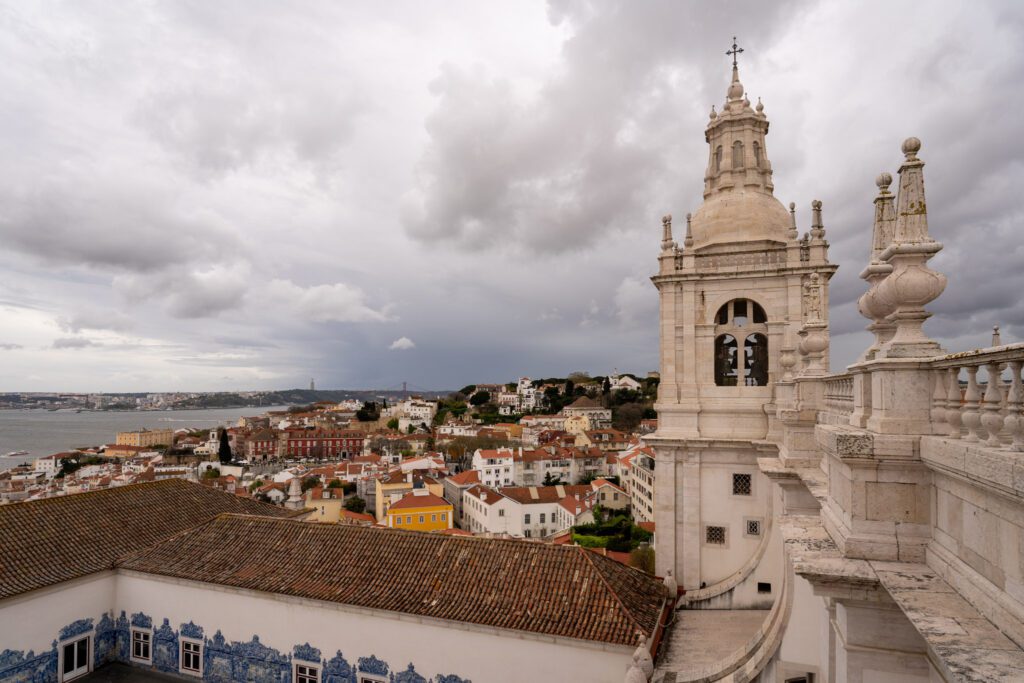
On my very first day in Lisbon years and years ago, I was standing at Miradouro das Portas do Sol in Alfama (previously mentioned in the “best views” section) staring at this rectangular church towering over the city further up the hill.
I asked about it, and our tour guide mentioned that it was worth visiting for a couple of reasons – the azulejos and the views from the roof – and I jotted it down in my notes and… never made it there on those first two trips.
So, on this latest trip, it was priority number one (tied with the Jerónimos Monastery) for my trip, and I’m here to tell you that it’s well worth the price of entry for both of the reasons mentioned.
The church and monastery are dedicated to the patron saint of Lisbon (whose statue is at the aforementioned Miradouro das Portas do Sol in Alfama), and the current iteration was built in the 17th Century.
The façade is relatively humble (as humble as a huge church can be, anyway), but the interior is gorgeous.
You have the azulejos lining the walls along with the tombs of the monarchs of Portugal from the House of Braganza (which sounds a lot like a Game of Thrones dynasty).
I spent a solid 30 minutes reading about the Braganza monarchs after I was here, and the story is nearly as interesting as the Medici family in Florence (or the Hapsburgs in Spain), which may not sound like it, but is high praise.
Here’s the short version: they won a war against a Spanish line of kings (who the Portuguese hated) and rose to the top of Portugal’s political pyramid, ruled Portugal and Brazil for a couple of centuries, and remained at the top until the early 20th Century, when they were toppled by republicans who believed the monarchy was a relic of the past.
Anyway, it’s worth seeing their tombs, and I physically jumped when I saw the statue praying over one of them, thinking it was a real person.
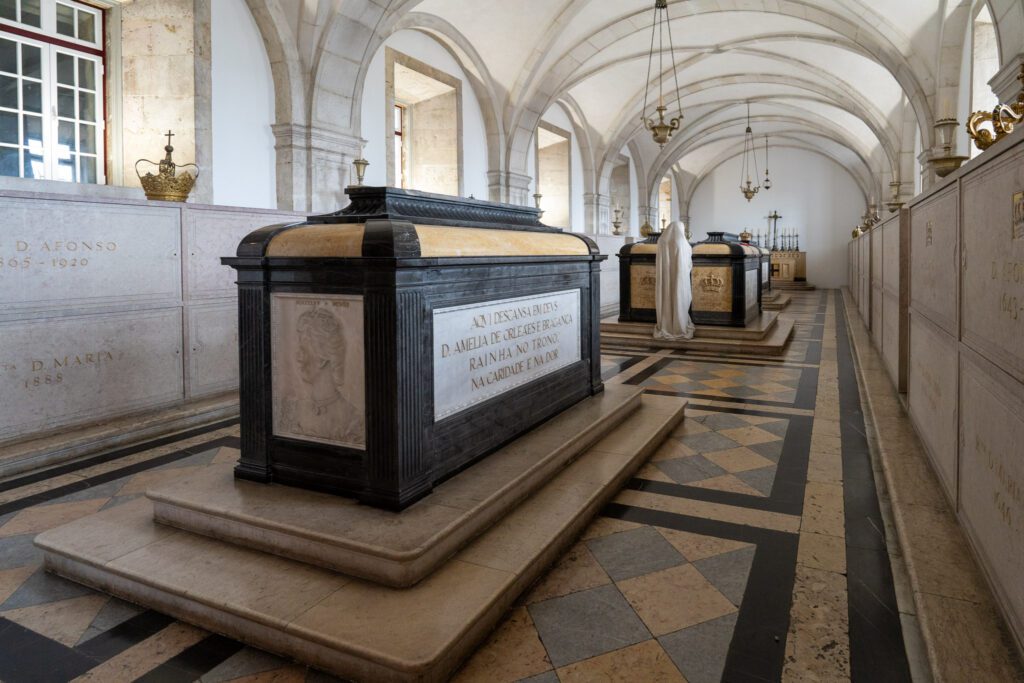
But that’s not even the most interesting thing to see here! I would point you to the azulejos and the view from the roof.
First, the azulejos.
The interior courtyards are lined with the famous blue tiles depicting scenes from Portugal’s history.
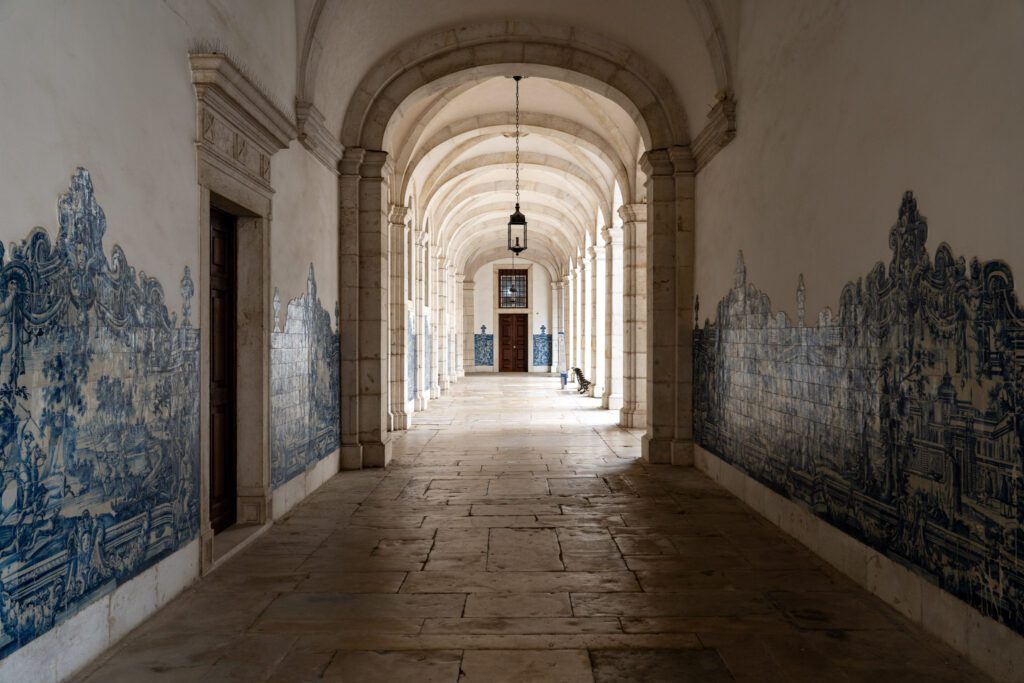
The more interesting grouping, though, is the collection of tiles inside that depict stories from the Fables of Jean de La Fontaine.
They’re like Aesop’s fables, but from the 17th Century and originally written in French. They have names like “the man and the lion” and “the hawk and the nightingale.”
There is a big collection of tiles depicting these stories, along with a brief description of each fable (is it always clear what exactly is being depicted? Definitely not).
Second, the view from the roof is equal if not better than the views from Alfama (but probably not from the views further up the hill).
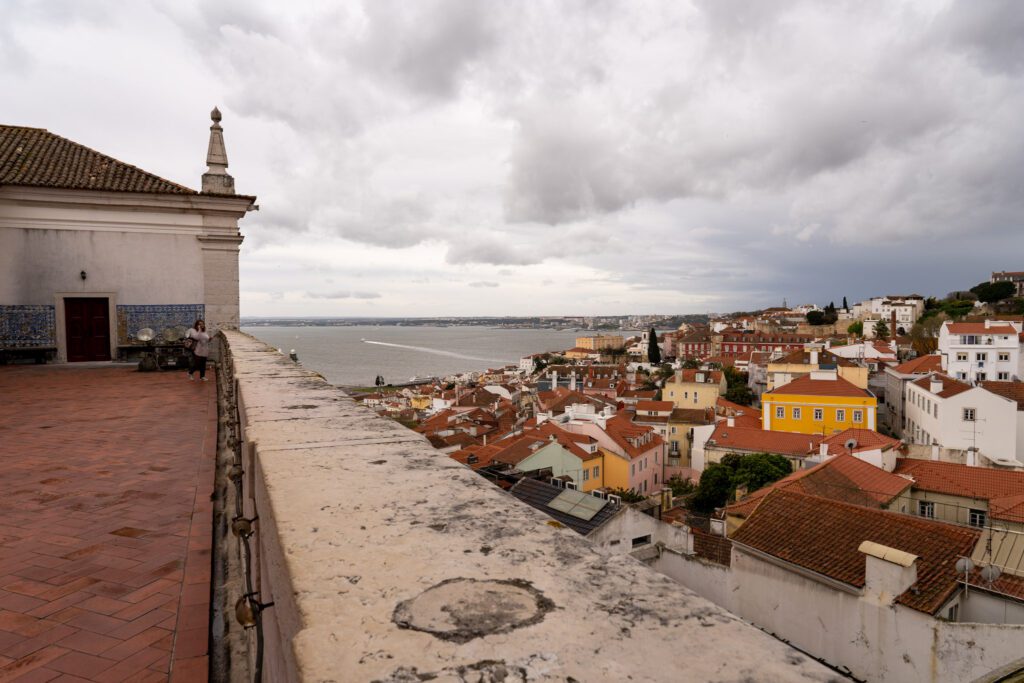
You have a sweeping 360 degree view out over Lisbon, and though I was here on a cloudy day, I was still glad I made the journey and the climb up (it’s not a particularly big climb or difficult).
More information, including hours and ticket prices, here. No need to buy in advance, you can buy them on arrival.
Get Out of the City for a Day
There are several great day trips from Lisbon that are an easy journey and offer something a little different than the city itself.
However, we’ve only done the trip to Sintra ourselves, so while we have the trip to the beaches in Cascais (and everything in Parque Natural da Arrábida, which is 40 minutes south of the city) and the hilltop towns north of Lisbon like Óbidos on our list, we’re not going to cover them in depth here because we haven’t done them ourselves.
However, that doesn’t mean you shouldn’t. Here’s our advice.
If you want beaches, Cascais is the easiest beach city to access from Lisbon (we’d head south to Arrábida or further north to Ericeira if you have a car for far fewer tourists).
If you want a beautiful hilltop walled city, Óbidos is a great option and is accessible via bus from Lisbon.
Now, let’s talk about Sintra. Sintra is a community that is a 45 minute train ride northwest of Lisbon, and it sits at the base of a mountain range that was the summer getaway for Portuguese kings.
Palácio Nacional da Pena, the famous brightly colored Romanticist palace atop the hill, was originally just a chapel on the hill back in the 15th Century.
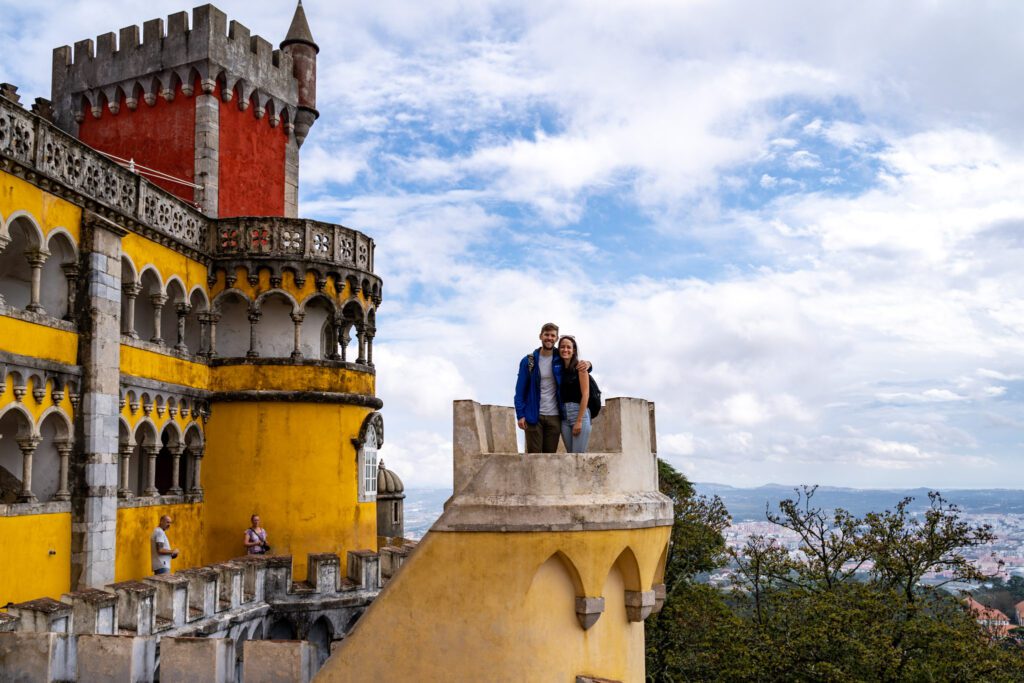
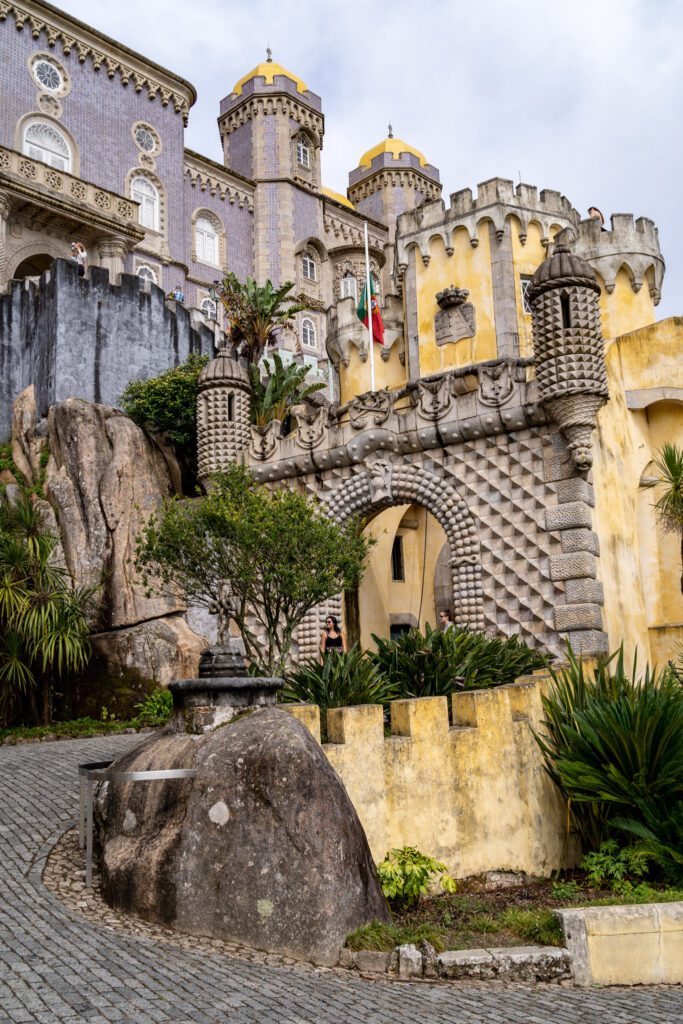
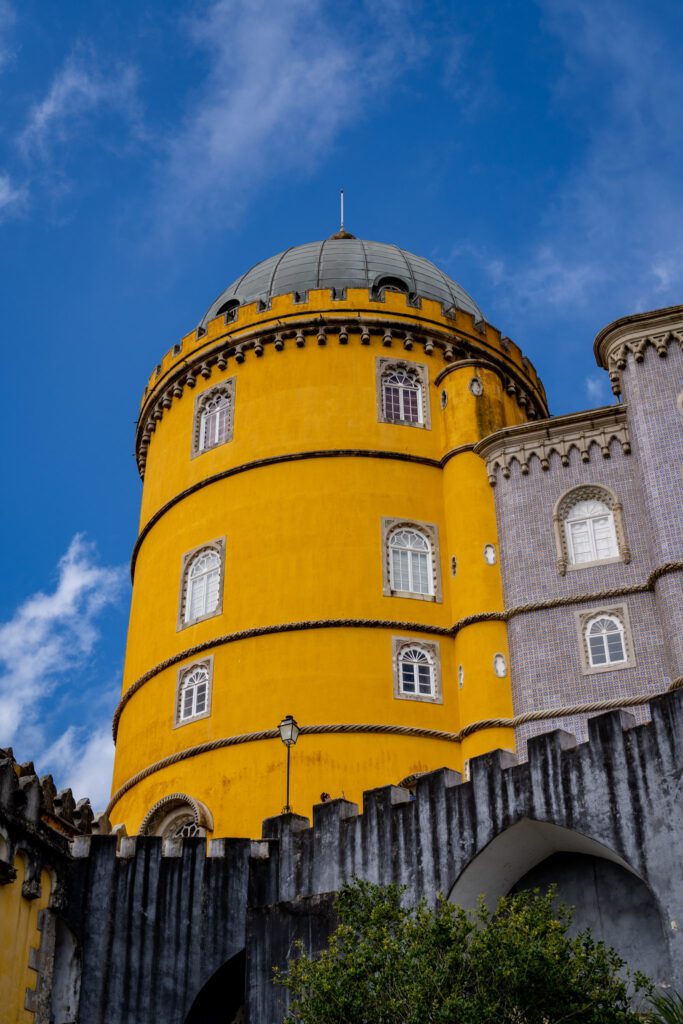
Like many things in Lisbon, it was left in ruin following the earthquake in 1755.
The land surrounding the palace (including the nearby Castelo do Mouros) was acquired by the royal family in the 19th Century, and the palace as you see it today was built then with an eye towards the cooler climate on the hilltop (which is close to the coast) for the hot Portuguese summers.
It’s an odd mishmash of architectural styles, mostly because the king had a heavy handed approach to working with the architect on the design, and it’s the most popular sight in Sintra for visitors.
In terms of prioritizing your time at Pena Palace, we’d recommend focusing your time on the grounds (walk through the gardens up to the Miradouro da Cruz Alta and down to the duck ponds) and on the exterior of the palace.
My brother went inside, and based on what’s in there (regal palaces all kind of end up being the same, in our experience) and the number of people inside, we’d skip the interior.
Instead, spend that time on the Castelo do Mouros, a recreation of the hilltop castle that was originally built here for defensive purposes back in the 8th or 9th Century that has excellent views out over the surrounding landscape, and the Quinta da Regaleira, an opulent estate that sees far fewer visitors and has the Initiation Well, a well with a spiral staircase that descends down into the earth that is pretty unique.
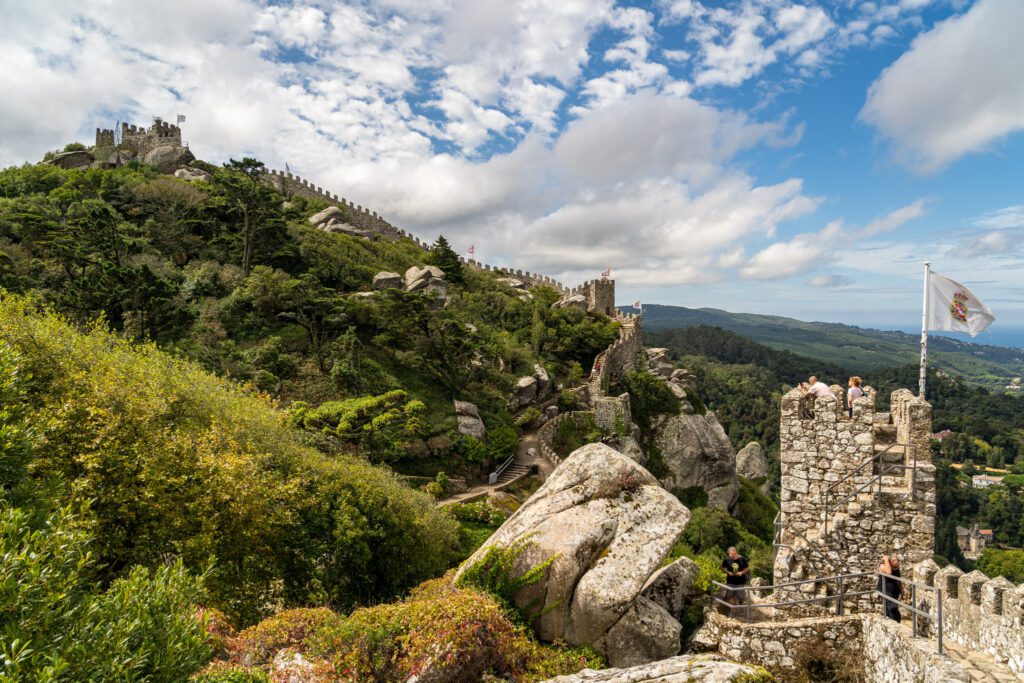
We have an entire guide dedicated to helping plan a day trip to Sintra, with all the details like how to get there, where to start (and what order to go in), and more details on each of the attractions.
You should head over and read that for more detail on what to do in Sintra.
Planning a trip to Portugal?
Here are our other Portugal travel guides to help you plan an incredible trip (even if you have to eat gluten free!).
If there’s no link below, it means we’re still working on it – long, in-depth guides take time! We’re working on it, though, we promise.
Portugal:
- Exactly How to Spend One Week in Portugal (for First Timers)
- 10 Days in Portugal: Planning the Perfect Portugal Itinerary
Lisbon
- 25 Incredible Things to Do in Lisbon: A Complete Guide
- 3 Days in Lisbon: Planning the Perfect Lisbon Itinerary
- One Day in Lisbon: The Best of Lisbon in 24 Hours
- Where to Stay in Lisbon: Our Guide to 4 Amazing Places to Stay
- Gluten Free Lisbon: A Complete Guide to Lisbon’s Best Gluten Free Restaurants
- The Best Coffee in Lisbon: 9 Amazing Lisbon Coffee Shops to Add to Your List
Porto:
- 3 Days in Porto: Planning the Perfect Porto Itinerary
- One Day in Porto: How to See the Best of Porto in a Day
- Where to Stay in Porto, Portugal: The 3 Best Places to Stay
The Algarve:
